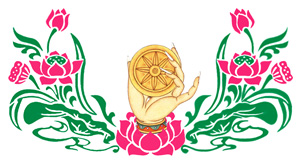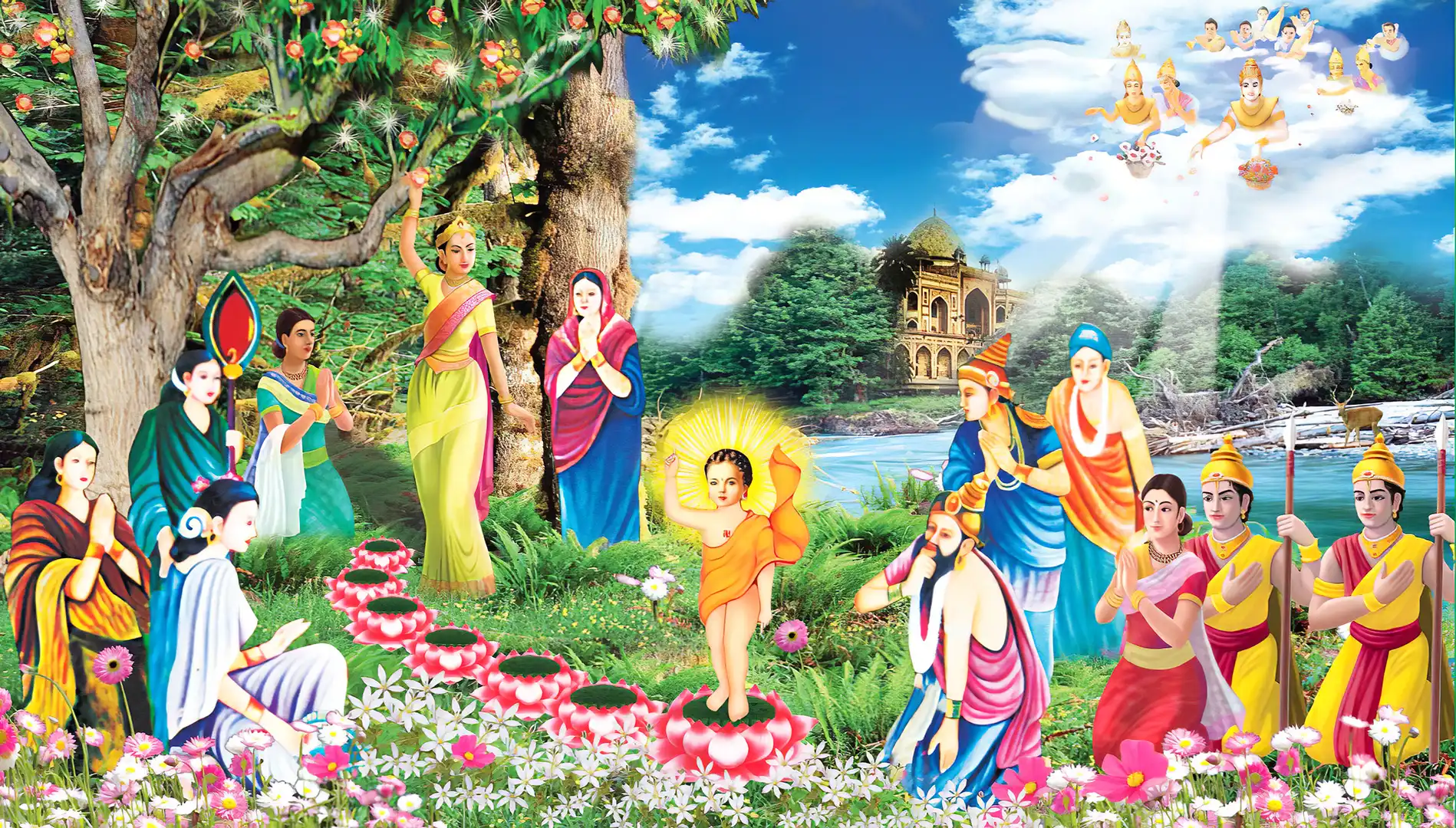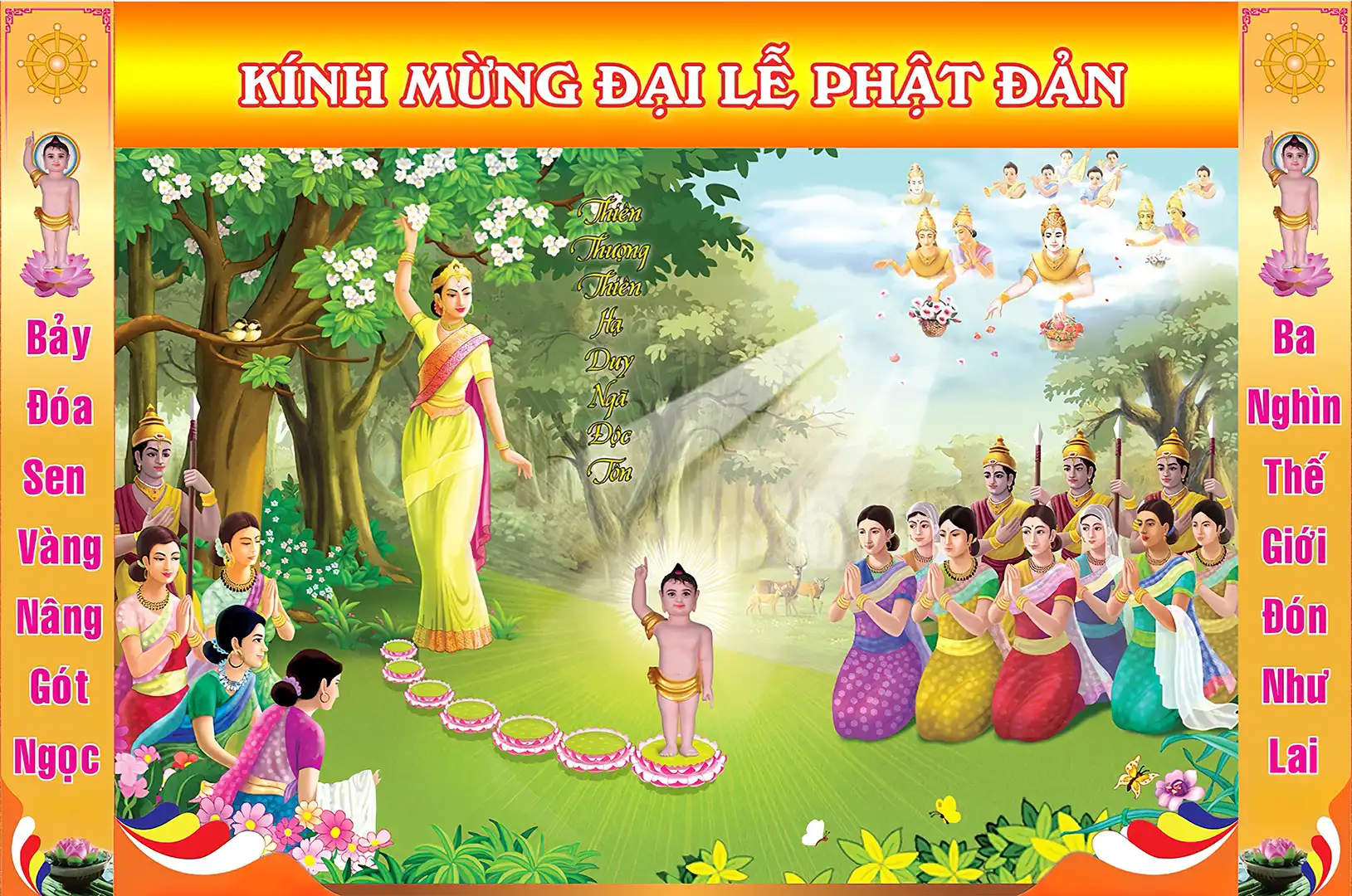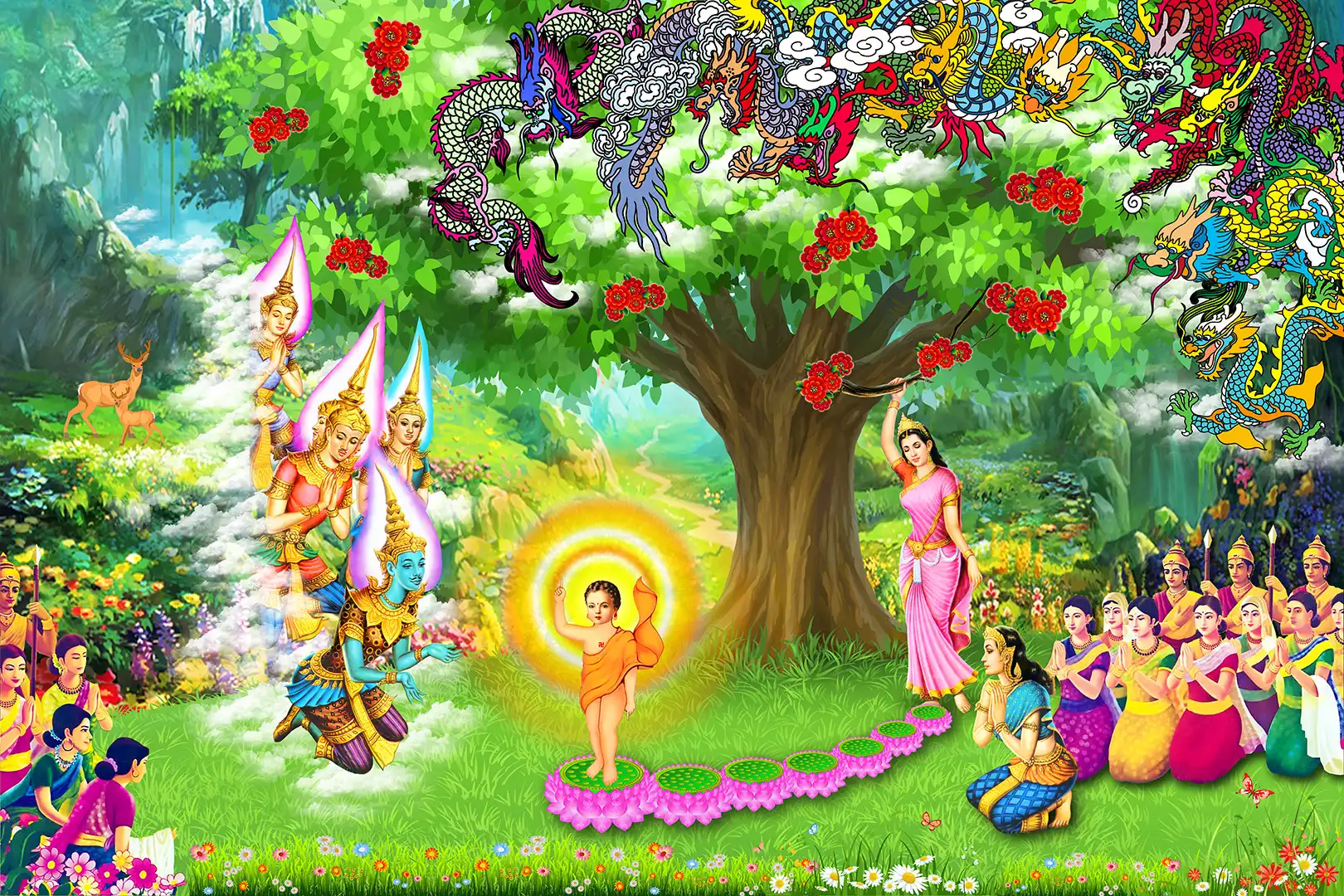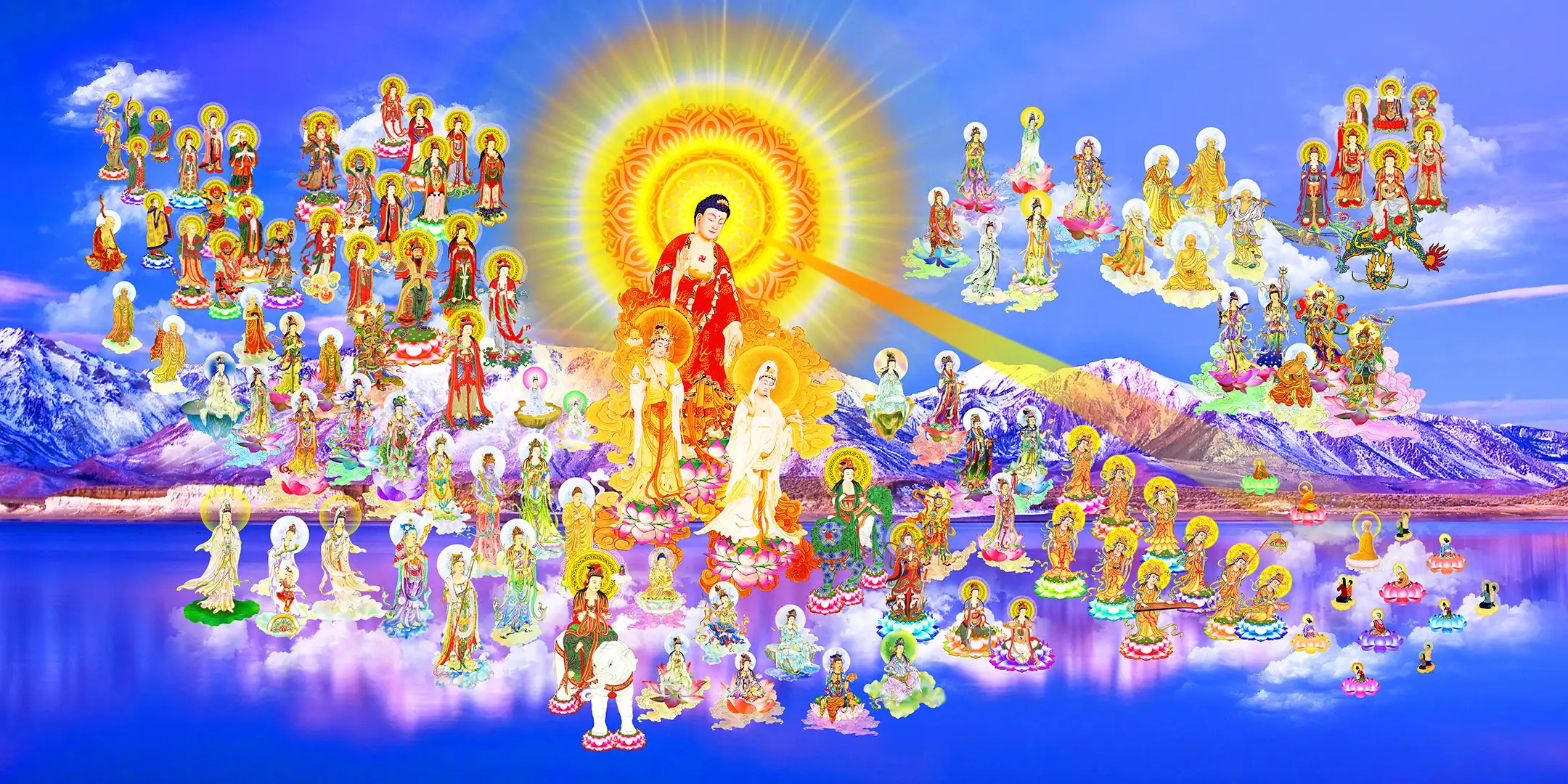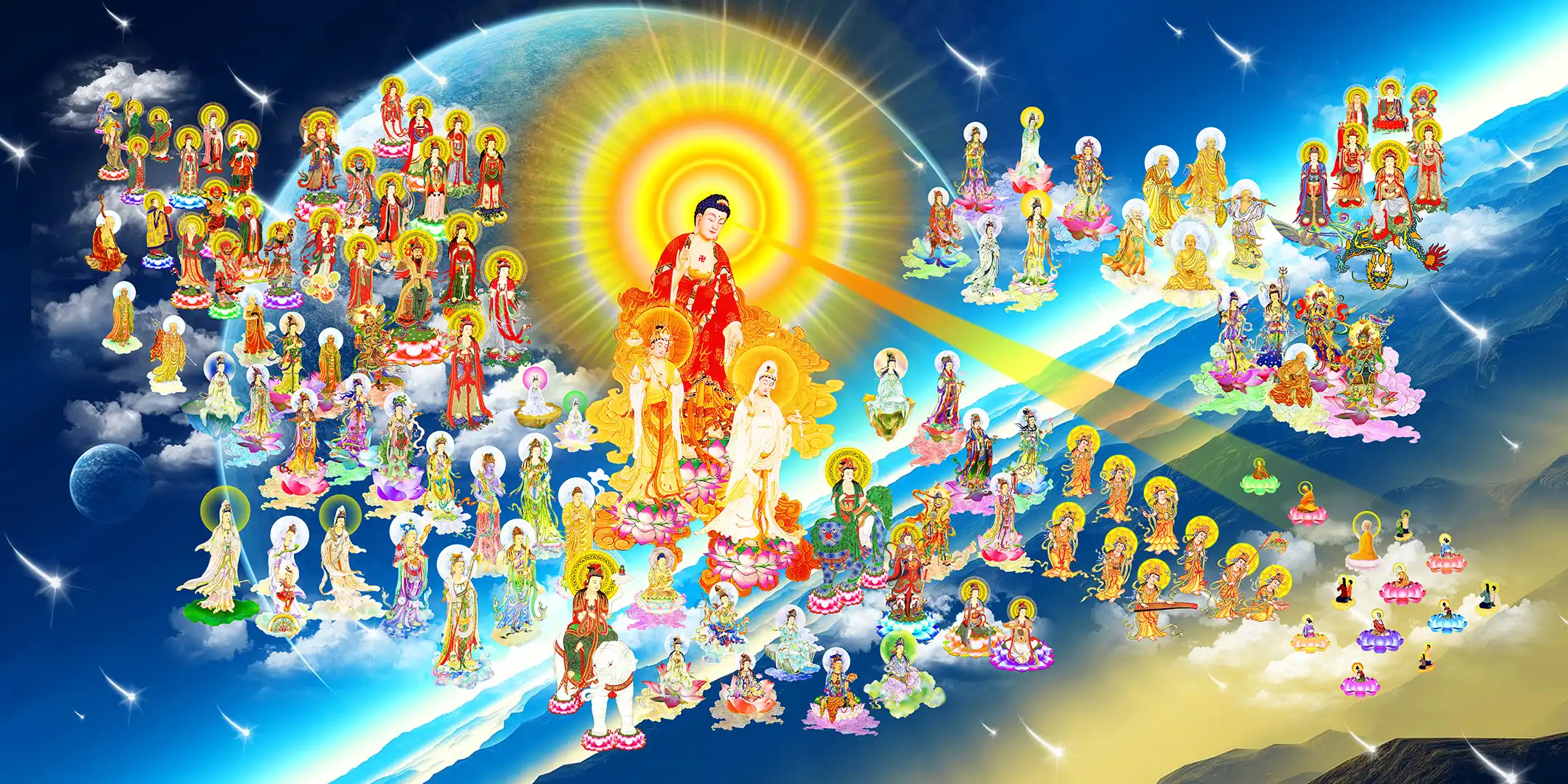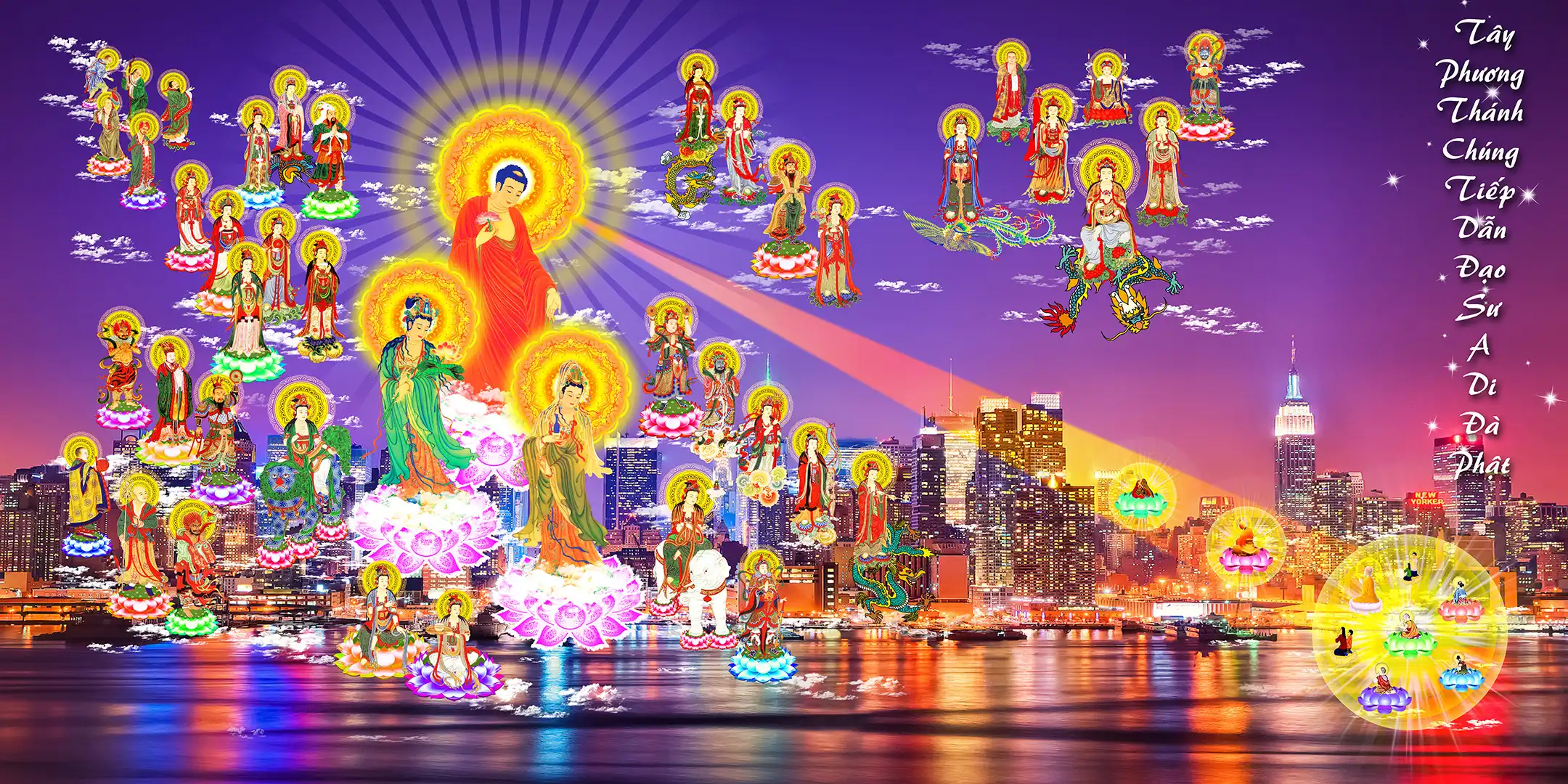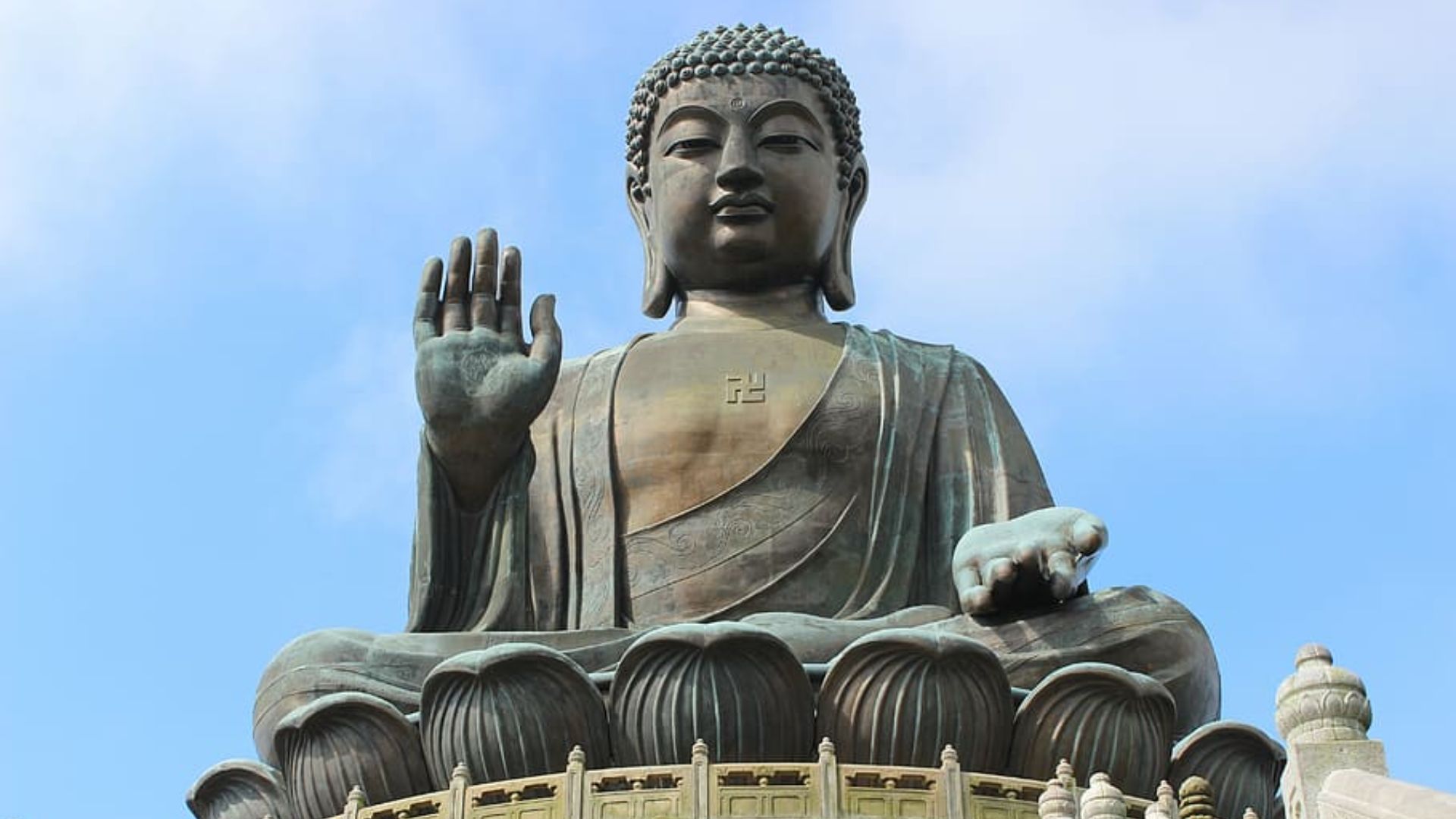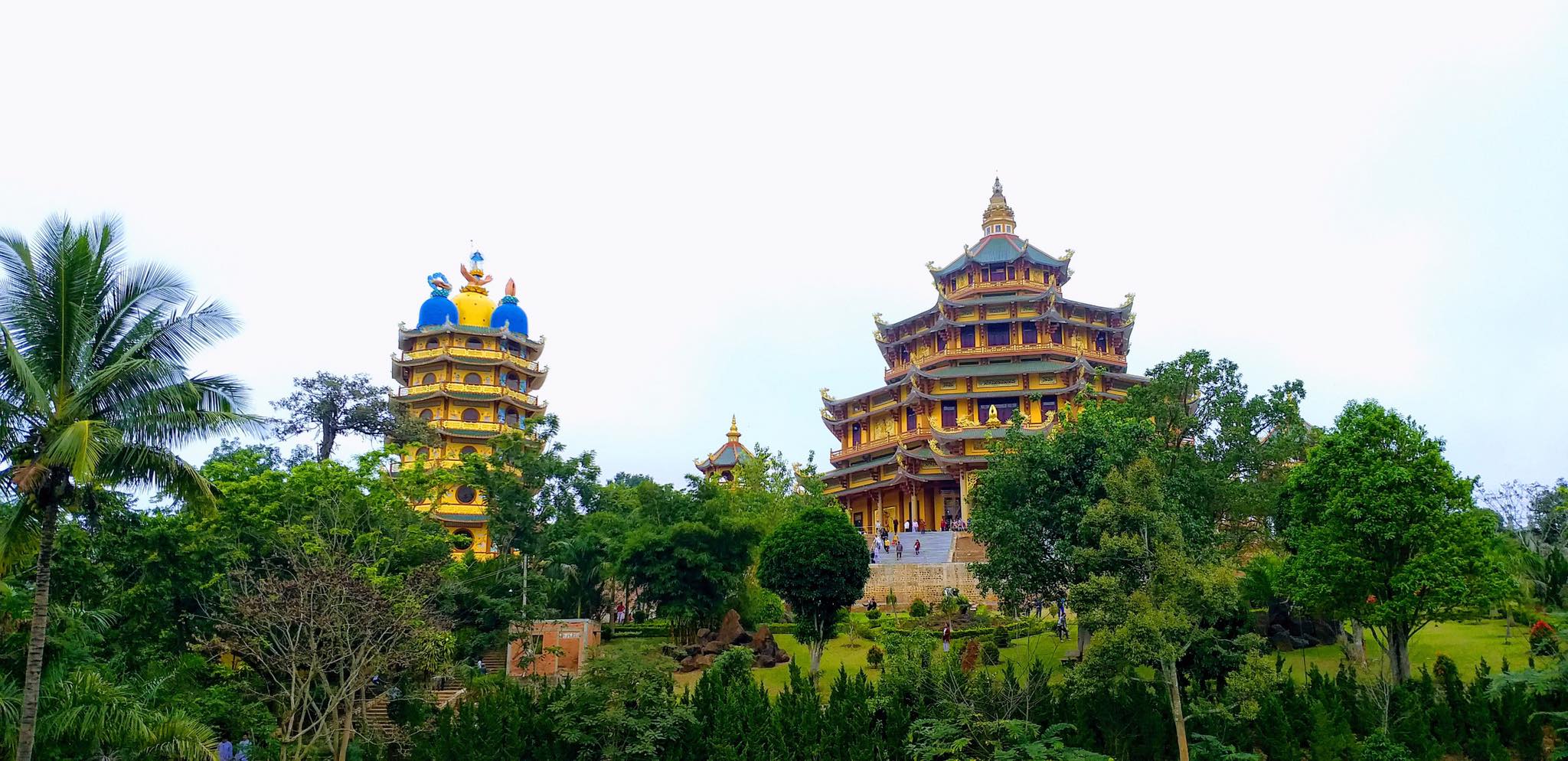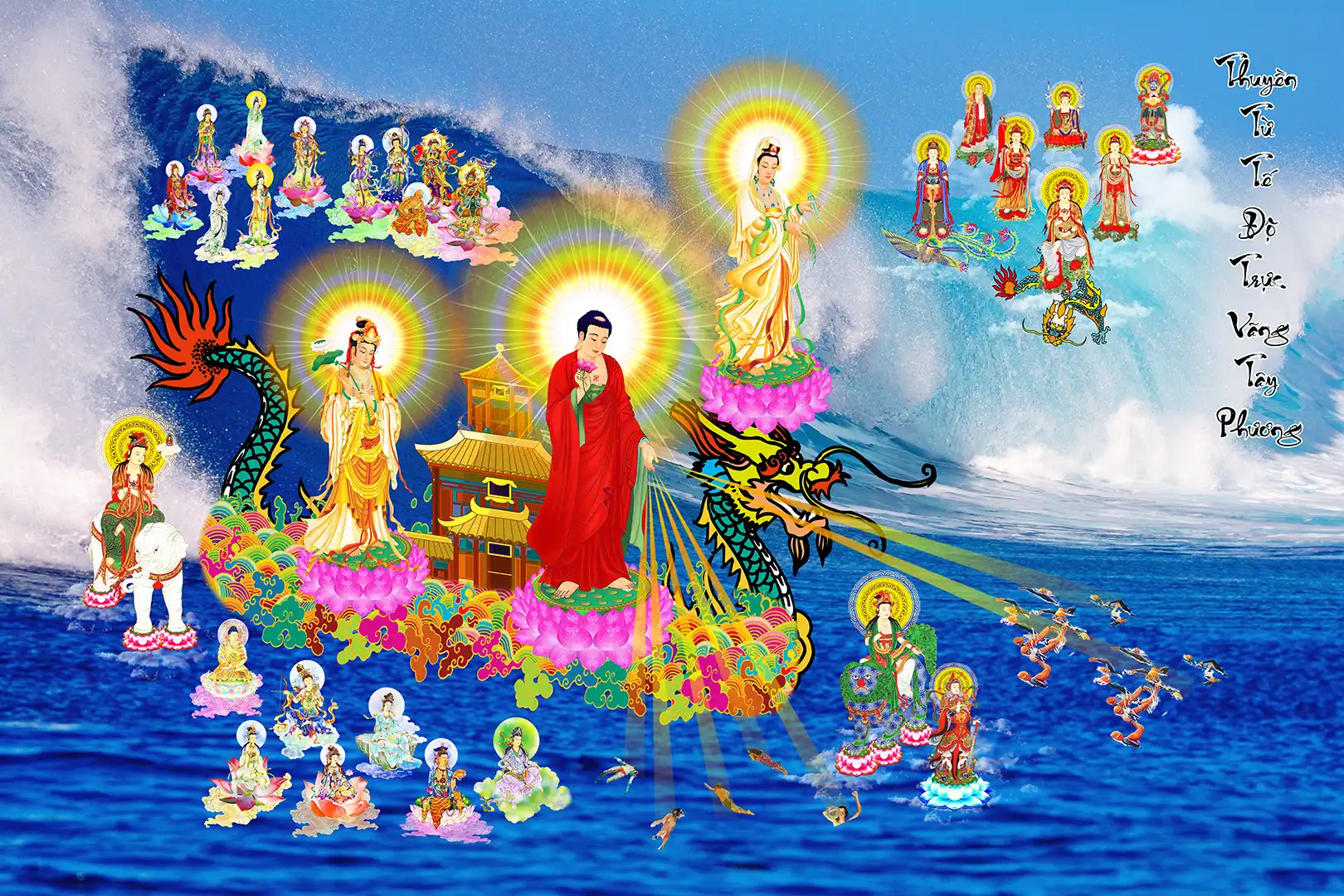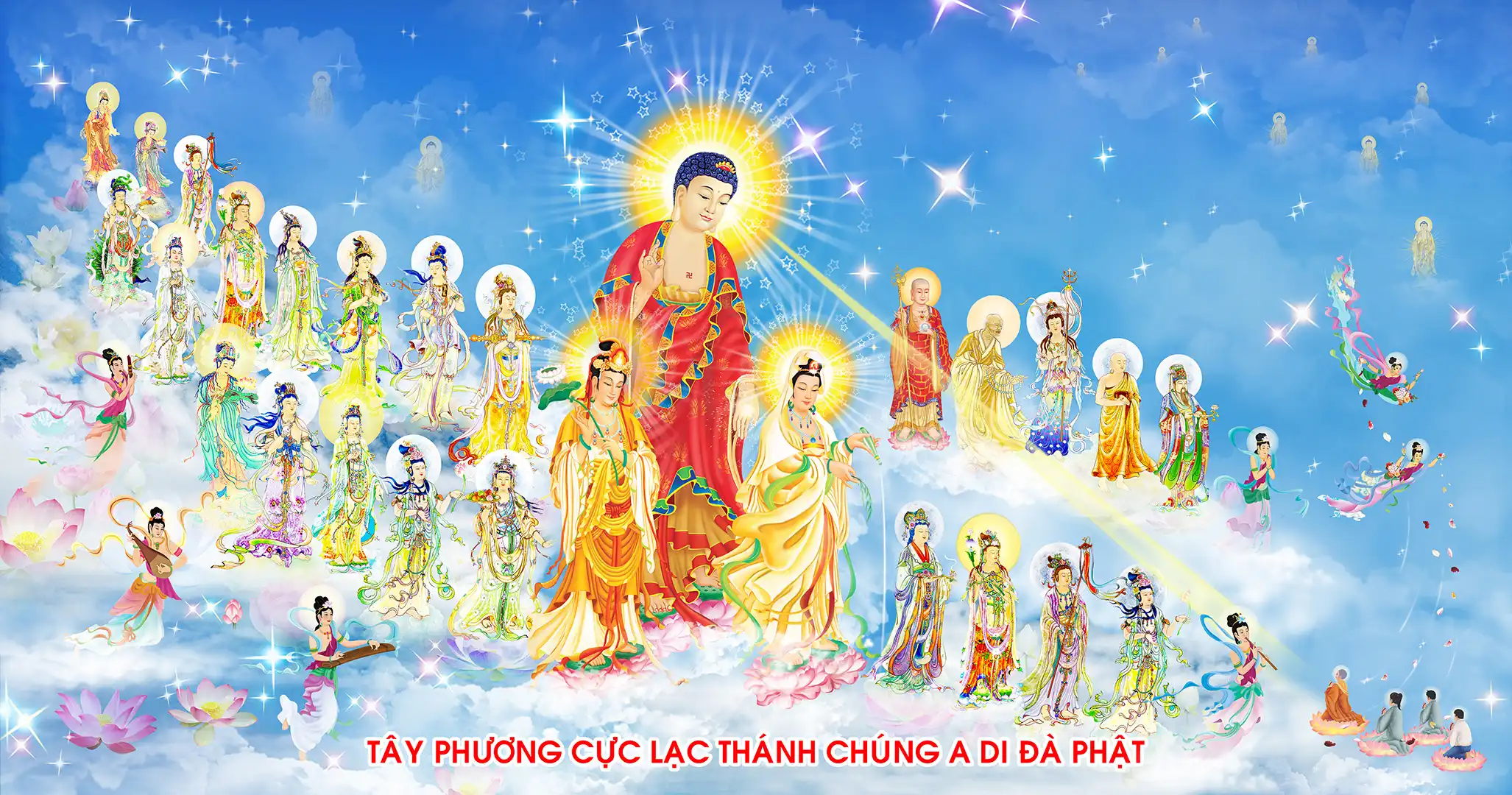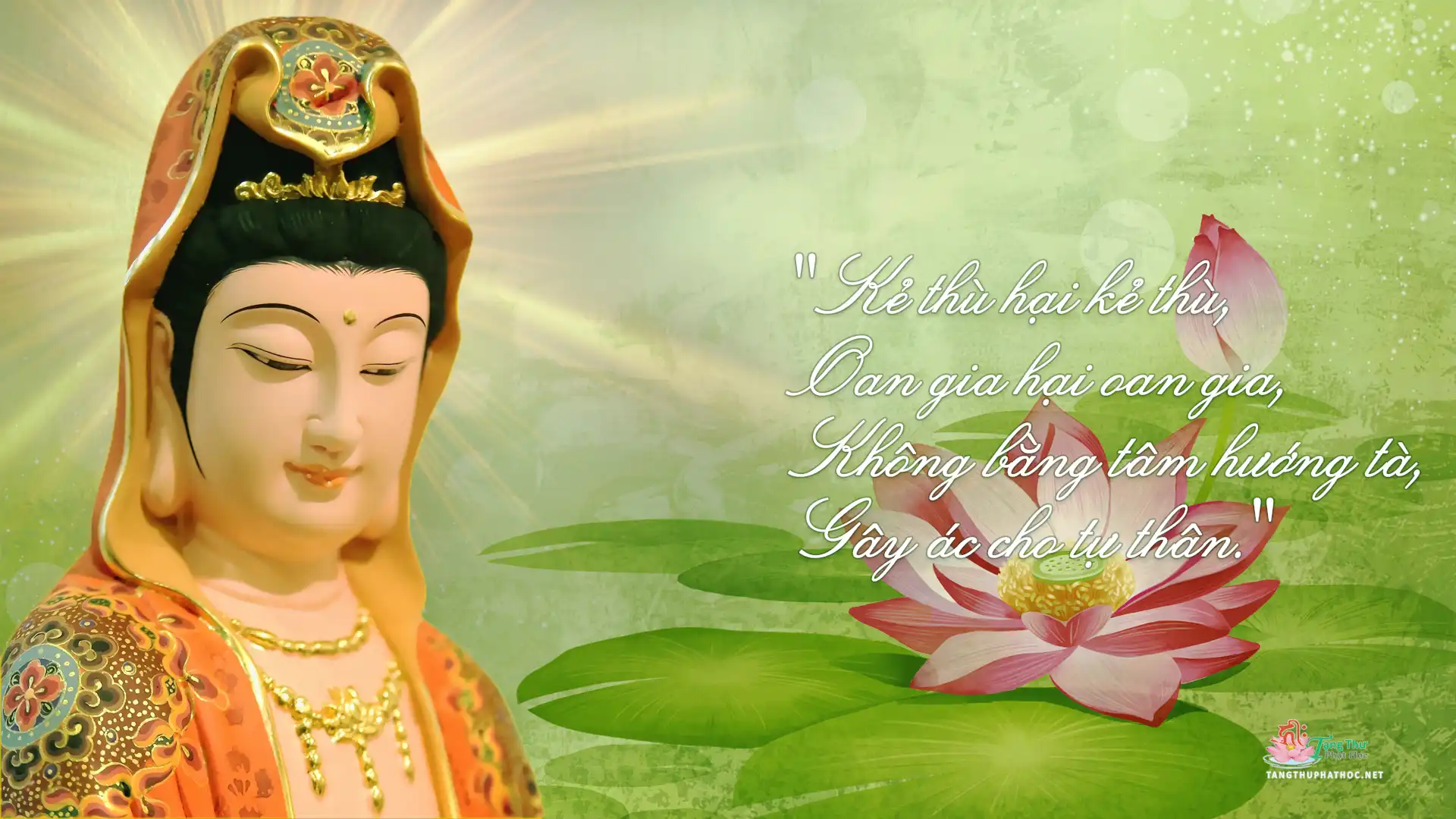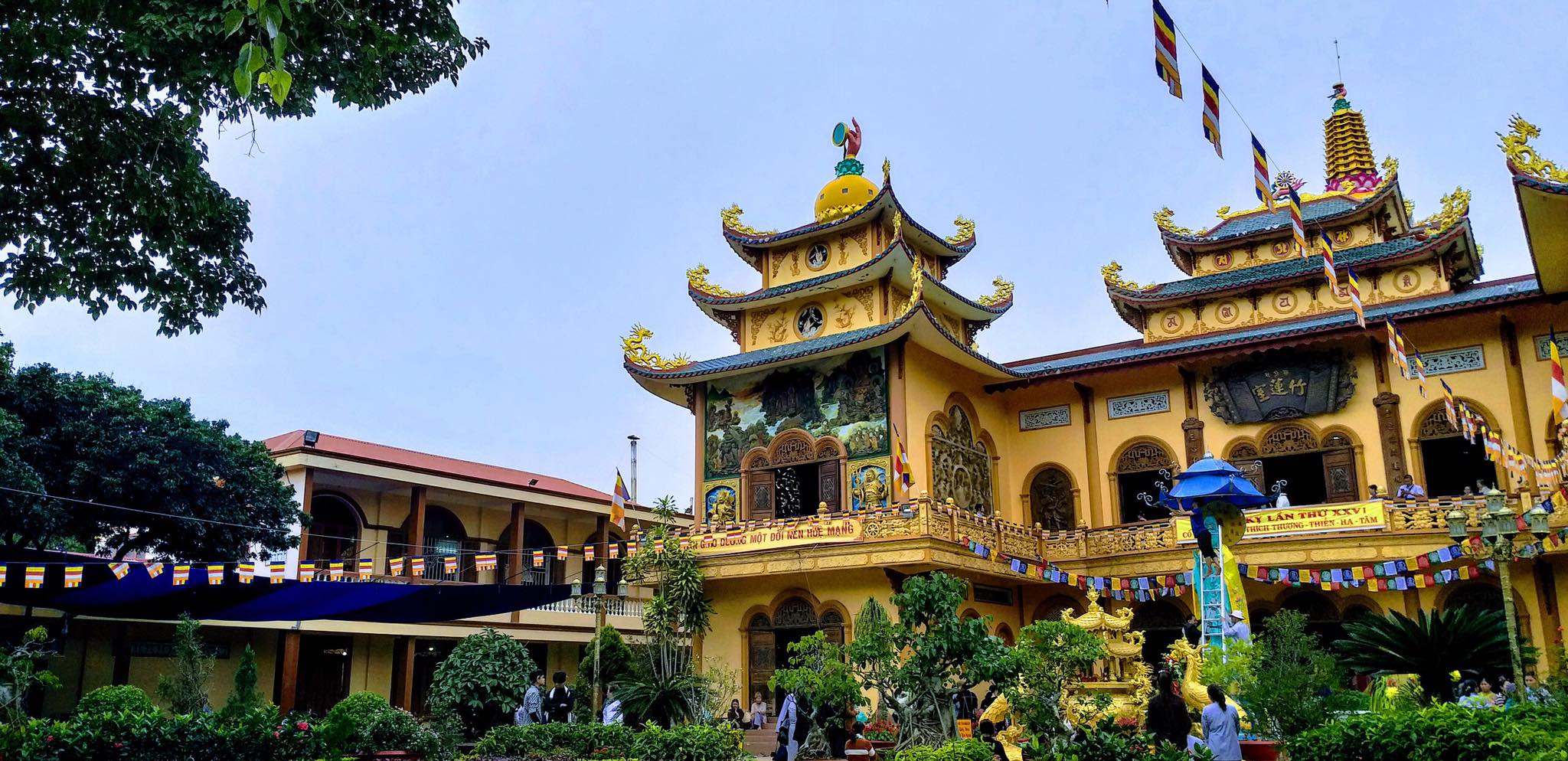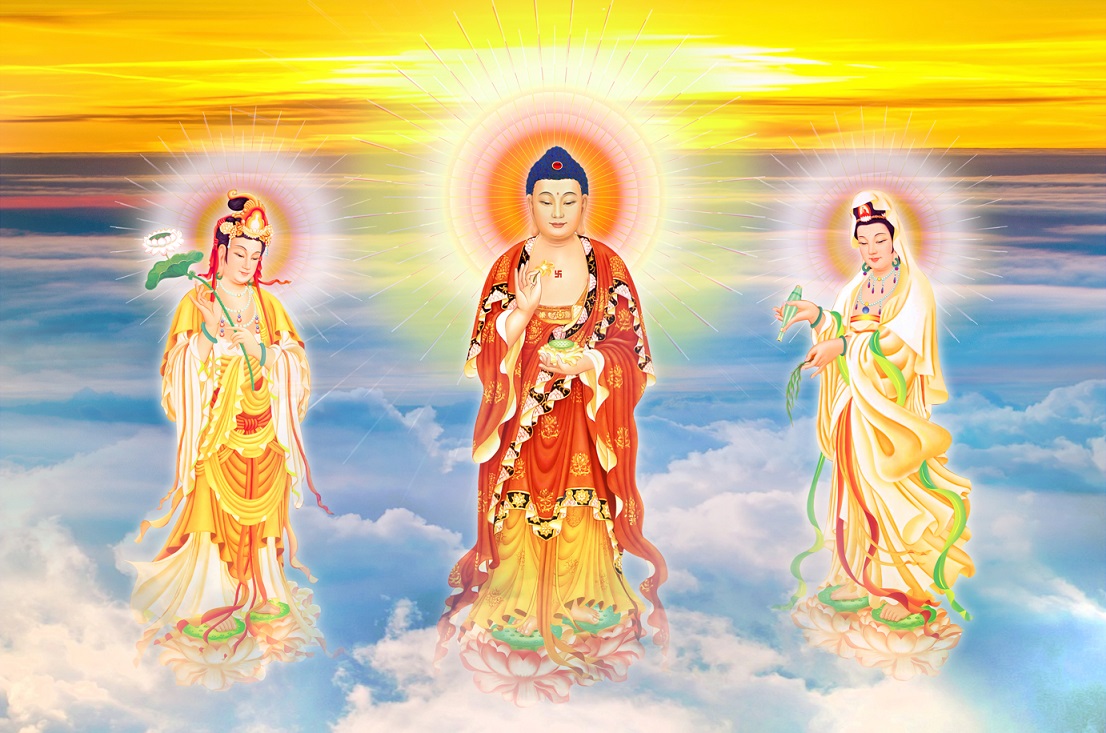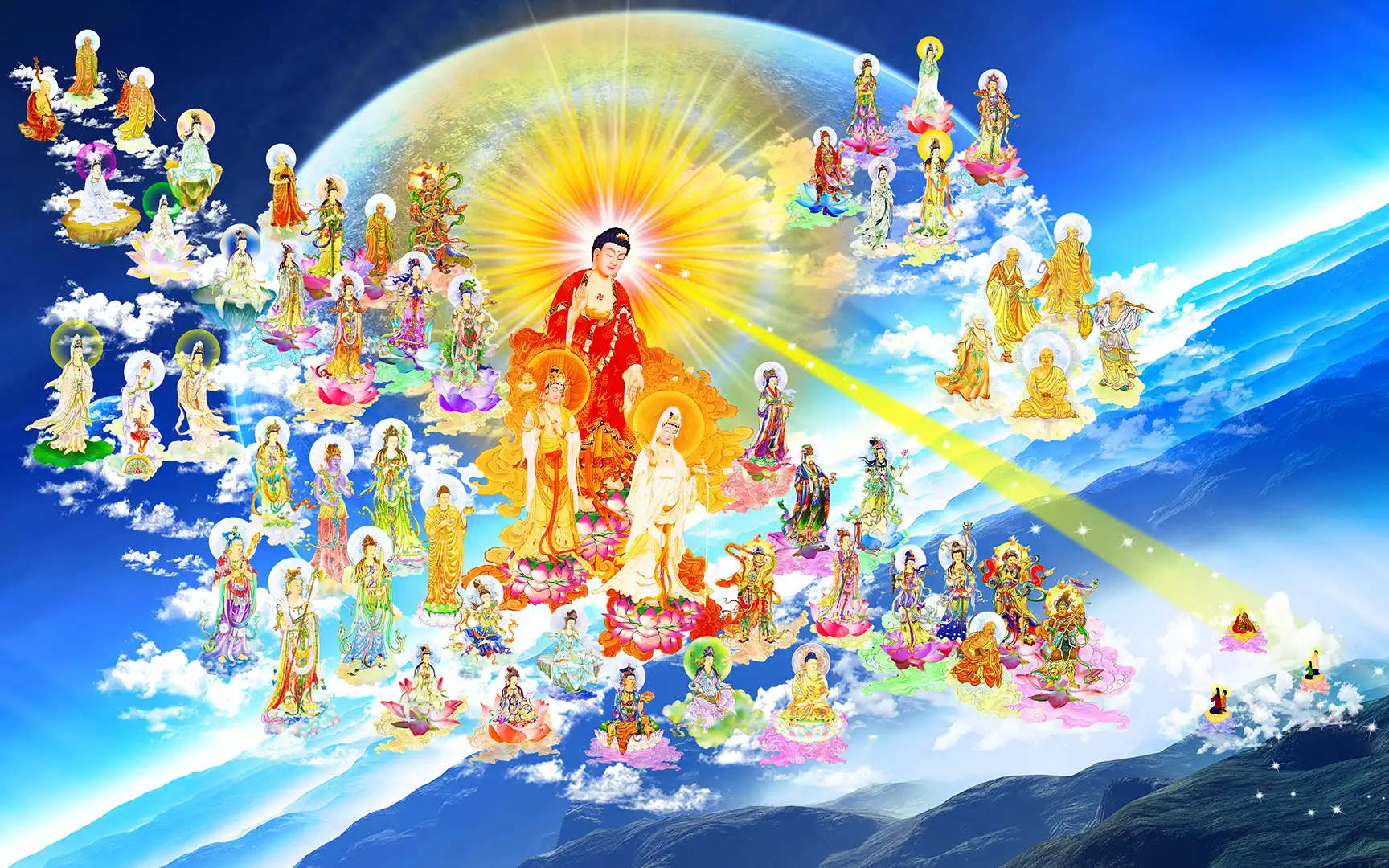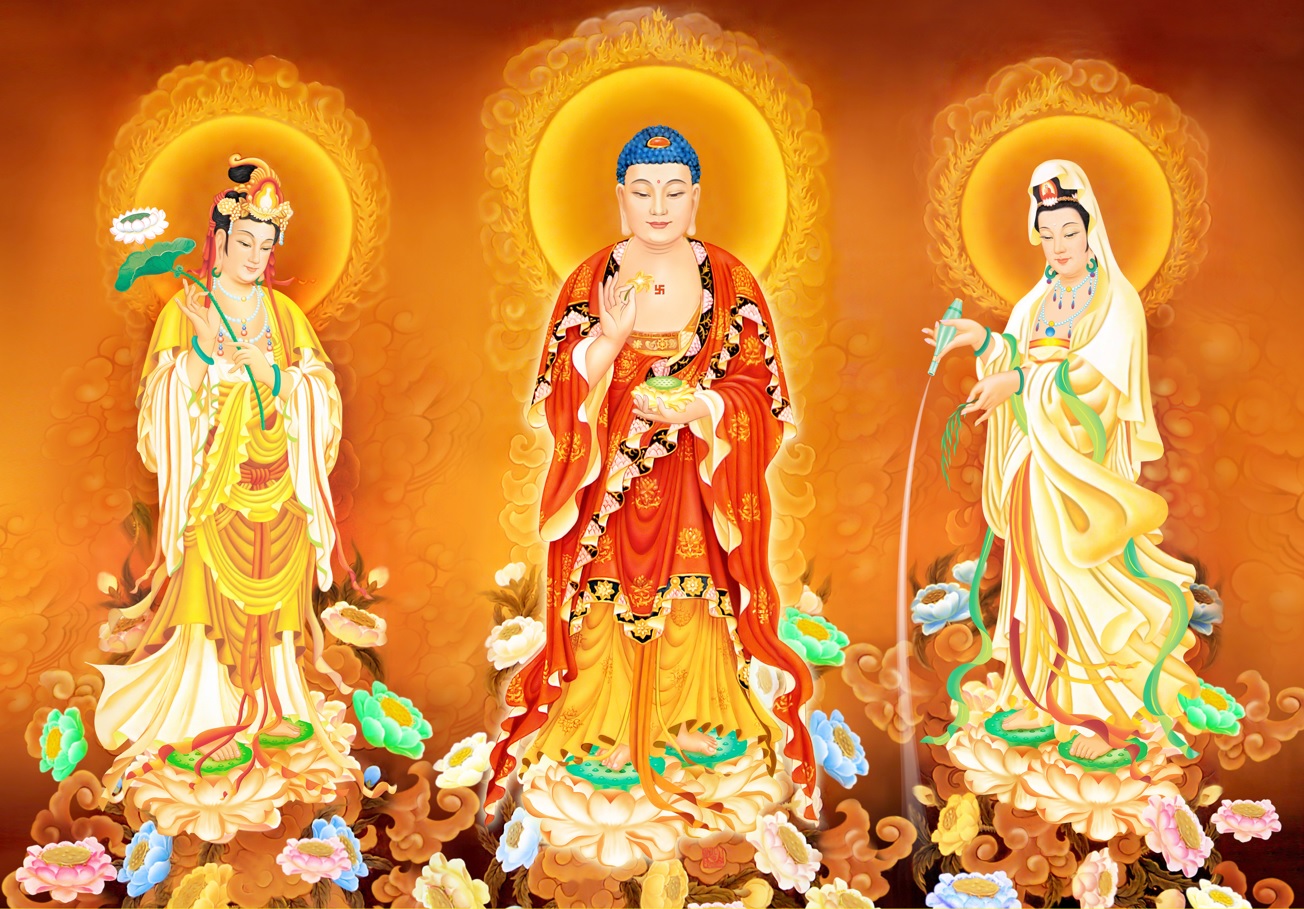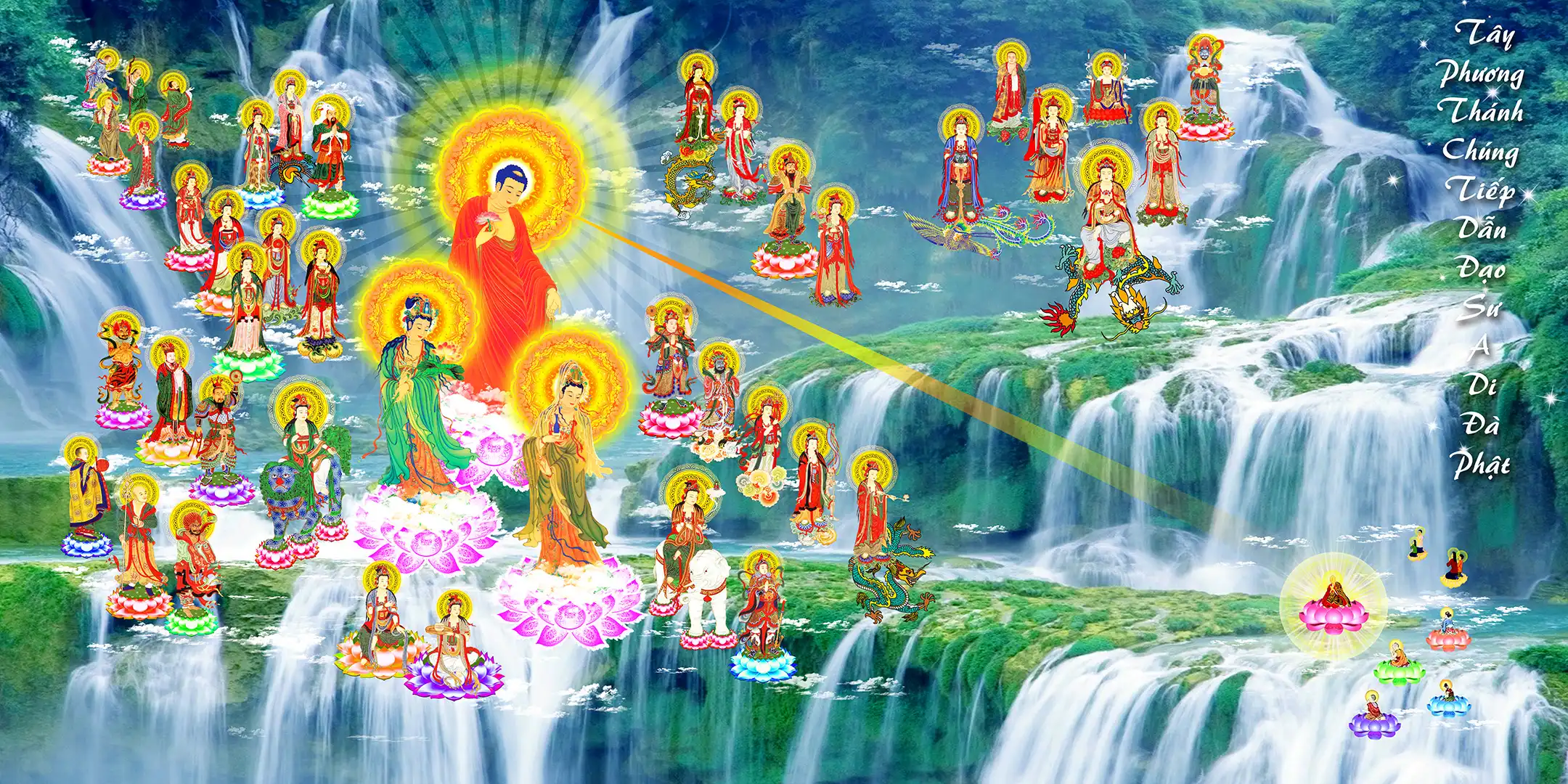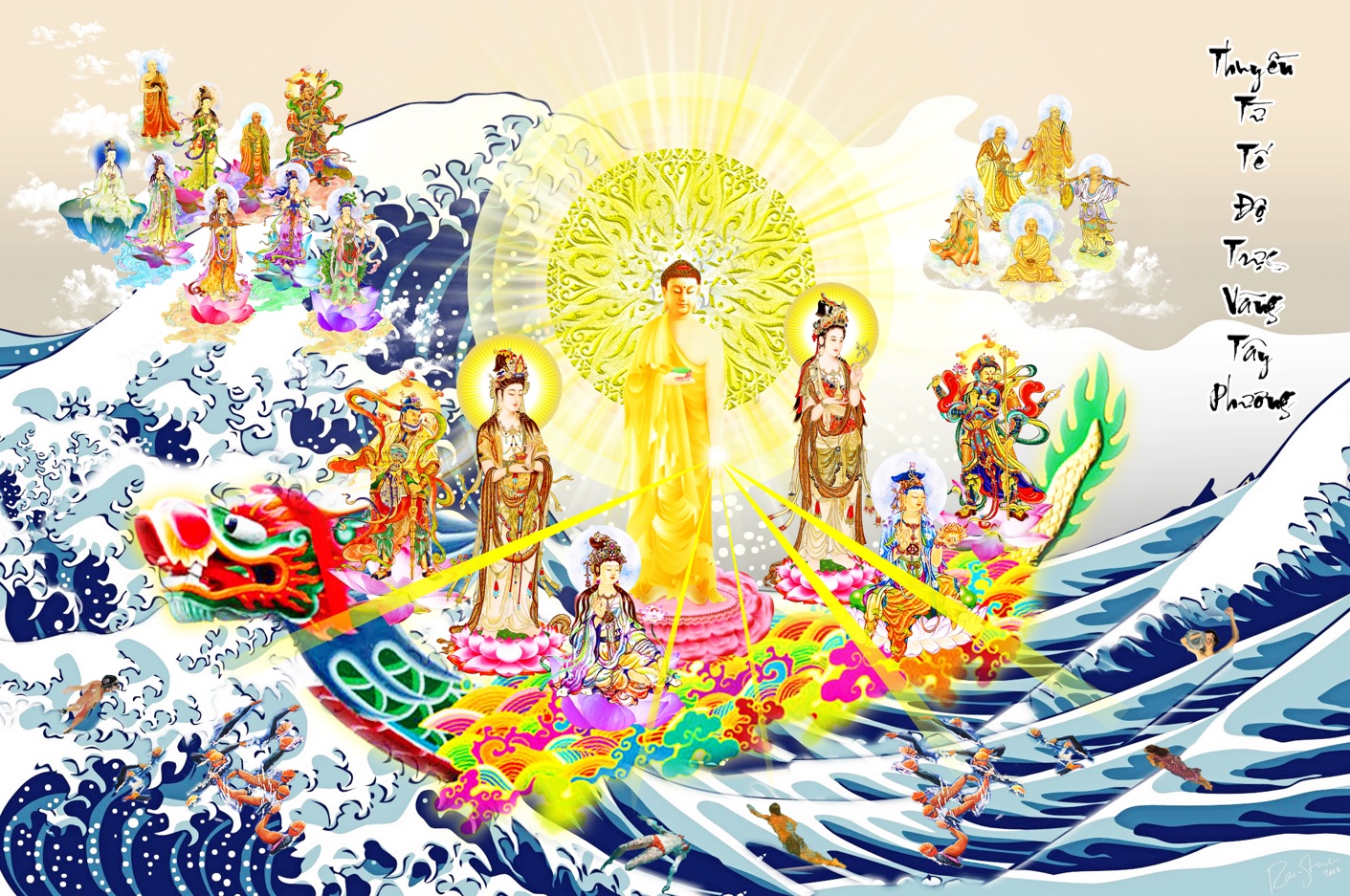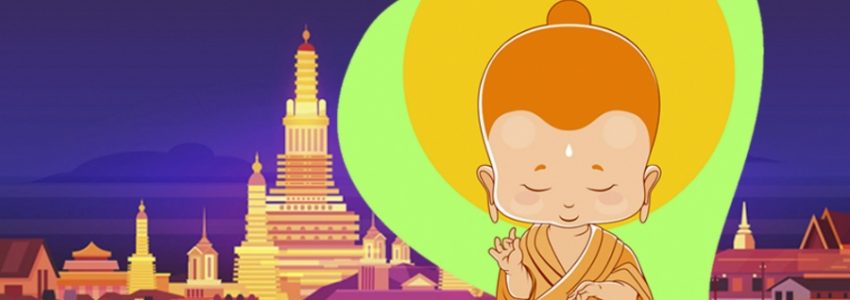THE SORROWLESS FLOWERS
Thiện Phúc
VOLUME III
521. Vajrayana Buddhism
522. Mahayanasraddhotpada Sastra
523. Types of Beings Who Can Tread the Path of the Mahayana
524. The Principle of Causation
525. The Principle of True Reality
526. The Principle of Totality
527. The Principle of Perfect Freedom
528. Five Periods and Eight Teachings of the T’ien T’ai School
529. Perfect Teaching
530. Dedication Equal to All Buddhas
531. Six Articles for Worship
532. Heretical Methods of Worship
533. Other Types of Cultivation
534. Renunciation
535. Two Aspects of a Buddhist Life
536. Attainment of Virtues
537. Great Renunciation
538. Mendicancy
539. Basis of Bodhisattvas
540. Twenty Parents and Relatives of Bodhisattvas
521. Vajrayana Buddhism
Vajrayana Yana is also called the Esoteric school or the Tibetan Buddhism. Nyingmapa, Kagyupa, Sakyapa và Gelugpa. The Vajrayana is often called Tibetan Buddhism, also called “True-Word” sect, and it is divided into four main sects: Nyingmapa, Kagyupa, Sakyapa, and Gelugpa. “Vajrayana” is a Sanskrit term for “Vajra vehicle.” A Tantric School of North India and Tibetan Buddhism founded in the fifth century. It developed out of the teachings of the Mahayana; however, it emphasized on ritual practices as a psychological method to attract followers. The scriptural basis for the tradition is a disparate collection of texts called “Tantras,” which were probably composed some time between the sixth-seventh centuries, but which are claimed to have been spoken by either Sakyamuni Buddha or other Buddhas. Vajrayana also follows the basic Bodhisattva path of Mahayana Buddhism. However, it teaches different methods that it claims shortening the time required to attain Buddhahood, including rituals, the use of hand mudra, Mandalas, and visualzations. A central practice is “deity yoga,” in which the meditator visualizes him or herself as a Buddha, possessing all the perfected qualities of a buddha, and engaging in compassionate activities. The tradition emphasizes the secrecy and efficacy of its practices, and generally requires that one receive initiation from qualified Guru before one enters onto the tantric path. Vajrayana became the dominant meditative tradition in Tibet and Mongolia, and is also found in East Asia in the schools of esoteric Buddhism, including the Chinese Chen-yen school in China and Vietnam, and the Japanese Shingon tradition. Sects of Vajrayana Buddhism in Tibet have many different branches. The Nyingmapa sect is the oldest Tibetan Buddhism, founded by Padmasambhava or Guru Rinpoche in the 8th century under the reign of King Trisong Detsen (742-797). The Kagyupa sect was founded by Marpa Chokyi Lodoe (1012-1099), a famous Tibetan translator in the 11th century and his outstanding disciple Milarepa (1040-1123) in the 12th century. The Sakyapa sect was founded by the Tibetan translator Drogmi Sakya Yeshe (992-1074) in the 11th century. The Gelugpa sect, the youngest and largest among the schools of Tibetan Buddhism, was founded by Thongkhapa (1357-1419) or Je Rinpoche in the 14th century.
522. Mahayanasraddhotpada Sastra
Treatise on the Awakening of Faith in the mahayana. Mahayana work from the 5th or 6th century, which explains the basic notions of the teaching on the Awakening. This is one of the most important book for Zen. The sastra was composed by Asvaghosa, basic doctrines and practices in Mahayana. Mahayanashraddhotpada-sastra is divided into five chapters. Treatise on the Awakening of Faith was composed for the following reasons mentioned below. First, in order to free all beings from suffering. Second, to spread the true teaching. Third, to support those on the path. Fourth, to awaken faith in beginners. Fifth, to show means from remaining free from bad influences. Sixth, to teach proper methods of meditation. Seventh, to present the advantages of reciting the name of Amitabha. Eighth, to provide an introduction to Dhyana. Ninth, explanations of the most important Mahayana terms. Tenth, exposition of the Mahayana on the threefold nature of the essence of the mind, on enlightenment and nonenlightenment, and on ignorance, presentation of the proper methods leading to enlightenment, refutation of the false teaching and preconception, as well as on the merit and virtues of a Bodhisattva. Eleventh, for Mahayana practices, for development of faith through the practices of generosity, discipline, patience, exertion, wisdom, and samatha-Vipashyana. Twelfth, to show advantages of Mahayana practices.
523. Three Types of Beings Who Can Tread the Path of the Mahayana
According to the Shrimaladevi-Sutra, three are three types of beings who can tread the path of the Mahayana. These are people who always aim at the ideal of the Bodhisattva, which it contrasts with the Arhat, the ideal of the “Hinayana.” It considers the Arhat to be selfish because the Arhat path leads to nirvana for oneself alone, while the Bodhisattva strives to bring all sentient beings to salvation. In other words, these people always wish to save all beings. First, those who realize the most profound wisdom or Prajna. Second, those who realize wisdom through hearing the teaching. Third, those who cannot realize supreme wisdom, but have devout faith in the Tathagata.
524. The Principle of Causation
According to Prof. Junjiro Takakusu in The Essentials of Buddhist Philosophy, all schools of Mahayana believe in the Principle of Causation. The theory of causation by Dharmadhatu is the climax of all the causation theories; it is actually the conclusion of the theory of causation origination, as it is the universal causation and is already within the theory of universal immanence, pansophism, cosmotheism, or whatever it may be called. The causation theory was explained first by action-influence, but as action originates in ideation, we had, secondly, the theory of causation by ideation-store. Since the ideation-store as the repository of seed-energy must originate from something else, we had, thirdly, the causation theory explained by the expression “Matrix of the Thus-come” (Tathagata-garbha) or Thusness. This curious term means that which conceals the Buddha. Because of concealment it has an impure side, but because of Buddhahood it has a pure side as well. It is a synonym of Thusness (Tathatva or Tathata, not Tattva=Thisness or Thatness) which has in its broadest sense both pure and impure nature. Through the energy of pure and impure causes it manifests the specific character of becoming as birth and death, or as good and evil. Thusness pervades all beings, or better, all beings are in the state of Thusness. Here, as the fourth stage, the causation theory by Dharmadhatu (universe) is set forth. It is the causation by all beings themselves and is the creation of the universe itself, or we can call it the causation by the common action-influence of all beings. Intensively considered the universe will be a manifestation of Thusness or the Matrix of Tathagata (Thus-come). But extensively considered it is the causation of the universe by the universe itself and nothing more.
These definitions on the principle of causation are based on the interpretation of Prof. Junjiro Takakusu in The Essentials of Buddhist Philosophy. Conditioned things arise from the secondary causes, in contrast with arising from the primal nature or bhutatatha (Tánh giác). Second, everything arises from conditions and not being spontaneous and self-contained has no separate and independent nature. Third, Buddhism does not give importance to the idea of the Root-Principle or the First Cause as other systems of philosophy often do; nor does it discuss the idea of cosmology . Naturally such a branch of philosophy as theology did not have grounds to develop in Buddhism. One should not expect any discussion of theology from a Buddhist philosopher. As for the problem of creation, Budhism is ready to accept any theory that science may advance, for Buddhism does not recognize any conflict between religion and science. Fourth, according to Buddhism, human beings and all living things are self-created or self-creating. The universe is not homocentric; it is a co-creation of all beings. Buddhism does not believe that all things came from one cause, but holds that everything is inevitably created out of more than two causes. The creations or becomings of the antecedent causes continue in time-series, past, present and future, like a chain. This chain is divided into twelve divisions and is called the Twelve Divisioned Cycle of Causation and Becomings. Since these divisions are interdependent, the process is called Dependent Production or Chain of causation. The formula of this theory is as follows: “From the existence of this, that becomes; from the happening of this, that happens. From the non-existence of this, that does not become; from the non-happening of this, that does not happen.”
525. The Principle of True Reality
According to Prof. Junjiro Takakusu in The Essentials of Buddhist Philosophy, thusness is the ultimate foundation of Buddhist thought concerning the real state of all that exists. It is natural for people to seek first the innermost essence among the outward appearance of all things or to seek an unchanging fact among many changing things. Failing in this, people try to distinguish the unknowable from the knowable, the real from the apparent, or the thing-in-itself from the thing-for-us. This effort, too, will end in failure, for what they select as the real or the thing-in-itself is utterly beyond human knowledge. Such efforts may be called the search for the world-principle or for the life-principle. The method of search and the resulting theories are various. Some are monistic or pantheistic, while others are dualistic or pluralistic. Against all these views Buddhism stands aloof by itself. Buddhism is atheistic, there is no doubt about it. When questioned about the First Cause or Principle, the Buddha always remained reticent. . As to the life-principle, he denied the existence of an ego or soul or any kind of thing which one may call the real self, as we have discussed. To see the true nature or the true state of all things is not to find one in many or one before many, nor is it to distinguish unity from diversity or the static from the dynamic. The true state without any special condition. It is, in fact, the true reality without a reality, i.e., without any specific character or nature. It is very difficult for the human mind to understand this idea of reality in which there is no substance at all. The idea of an abiding substance with changing qualities is very deeply rooted in our habits of thought. Buddhist schools, no matter what they are, Hinayana or Mahayana, realistic or idealistic, are utterly free from such a habit of thought and all maintain the theory of pure change without substratum. When any Buddhist speaks of the true state of reality he means the state without a specific nature. According to the general views of the Hinayana, the state without any specific condition is Nirvana, because Nirvana is perfect freedom from bondage. The Realistic School (Sarvastivada), belonging to the Hinayana, goes a step further and assumes that selflessness, impermanence and Nirvana (flamelessness) are the true state of all things. Nihilistic School (Satyasiddhi) holds that all things, matter and mind, are void or unreal and that nothing exists even in Nirvana. The Mahayana teaches, on the other hand, that the truth can be discovered only by negative views of becoming, and, on the other hand, holds that true perfection can be realized negatively in the denial of the illusory and causal nature of existence. The Wreath School of the Mahayana thinks that the ideal world, or the World One-and-True, is without any independent individual. The Lotus School identifies the manifested state as it is and the true entity immanent-in-nature. On the whole, to see only the fact that a flower is falling is, after all, a one-sided view according to the theory of impermanence. We ought to see that immanent in the fact of a flower’s falling there lies the fact of a flower’s blooming, and also immanent in the blooming of the flower there is the fact of its falling. Thus the opposition of falling (extinction) and blooming (becoming) is synthesized and we form the view of reciprocal identification which is an unbiased view of the mean, or Middle Path. This amounts to saying that we see inaction in action and action in inaction, immotion in motion and motion in inmotion, calm in wave and wave in calm. We thus arrive at the true state of all things, i.e., the Middle Path. Anh this is what is meant by Thusness or Suchness. When the view is negatively expressed it indicates the true negation or Void, because any special state of thing is denied altogether. Such is considered to be the ultimate idea of Buddhist philosophy. When the ultimate principle is considered from the universal point of view, it is called “the Realm of Principle” (Dharmadhatu), but when it is considered from the personal point of view, it is named “the Matrix of Thus-come or Thus-gone” (Tathagata-garbha). Other ways of expressing this same idea are: the Buddha-nature (Buddhata or Buddha-svabhava), and the Spiritual or Law-body (Dharmakaya). These are all practically synonymous. Without knowing the principle of Thusness or Void in the highest sense of the word, one can in no way understand the Mahayana doctrine. The word ‘void’ in its highest sense does not mean ‘nothingness,’ but indicates ‘devoid of special conditions,’ or ‘unconditioned’.
526. The Principle of Totality
According to Prof. Junjiro Takakusu in The Essentials of Buddhist Philosophy, totality means a complete combination. The totality means the absolute in the relative and vice-versa. The identity of apparent contraries; perfect harmony among all differences. As in water and waves. Waves are one with waves, and water is one with water, and water and wave are one. As in affliction (passion) and enlightenment. As in transmigration of life and death and nirvana. As in life and death. All are of the same fundamental nature, all are bhutatathata, bhutatathata is all.
527. The Principle of Perfect Freedom
To understand Buddhism properly we must begin at the end of the Buddha’s career. The year 486 B.C. or thereabouts saw the conclusion of the Buddha’s activity as a teacher in India. The death of the Buddha is called, as is well known, ‘Nirvana,’ or ‘the state of the fire blown out.’ When a fire is blown out, nothing remain to be seen. So the Buddha was considered to have enetered into an invisible state which can in no way be depicted in word or in form. Just prior to his attaining Nirvana, in the Sala grove of Kusinagara, the Buddha spoke to His disciples to the following effect: “Do not wail saying ‘Our Teacher has pased away, and we have no one to follow.’ What I have taught, the Dharma (ideal) with the disciplinary (Vinaya) rules, will be your teacher after my departure. If you adhere to them and practice them uninterruptedly, is it not the same as if my Dharma-body (Dharmakaya) remained here forever?” In spite of these thoughtful instructions some of his disciples were expressing a dissenting idea even before his funeral. It was natural, therefore, for the mindful elders to think of calling a council of elders in order to preserve the orthodox teaching of the Buddha. They consulted King Ajatasatru who at once ordered the eighteen monasteries around his capital to be repaired for housing the members of the coming Council of Rajagriha. When the time arrived five hundred selected elders met together. Ananda rehearsed the Dharmas (sutras) while Upali explained the origin of each of the Vinaya rules. There was no necessity of rehearsing the Vinaya rules themselves since they had been compiled during the Buddha’s lifetime for weekly convocation for confessions. At the council a fine collection of the Dharma and the Vinaya was made, the number of Sutras was decided, and the history of the disciplinary rules was compiled. The result of the elders’ activity was acknowledged as an authority by those who had a formalistic and realistic tendency. There were , however, some who differed from them in their opinion. Purana, for instance, was skilled in preaching. Purana was in a bamboo grove near Rajagriha during the council, and, being asked by some layman, is said to have answered: “The council may produce a fine collection. But I will keep to what I heard from my teacher myself. So we may presume that there were some who had idealistic and free-thinking tendencies.
528. Five Periods and Eight Teachings of the T’ien T’ai School
In the centuries that followed the Buddha’s death, various attempts were made to organize and formulate his teachings. Different systems appeared, basing themselves on the recorded scriptures, each purporting to express the Buddha’s intended meaning from the time of his enlightenment until his nirvana. The reason of his teachings of different sutras is for the benefits of many different living beings, but the purpose of his doctrine was always the same. “Five Periods and Eight Teachings of the T’ien T’ai school” is a classification of the Buddha’s teachings from the standpoint of the T’ien-T’ai sect, made by its Chinese founder Chih-I. The school of Celestial Platform of which doctrine is based on the Lotus Sutra and sees Nagarjuna as its first patriarch. This sect takes advantage of all expedients to practice to attain enlightenment. The classification of sutras and the teachings of Buddha into five periods (or five stages) and eight teachings (four doctrines plus four methods of expounding them) represents and attempt to systematize the teachings of Buddha. Five Periods in which the Avatamsaka period lasted for twenty-one days, the Agama period for twelve years, the Vaipulya period for eight years, the Prajna period for twenty-two years, and the Nirvana period for eight years. First, the Time of the Wreath (fresh milk of the Hua-Yen). Buddha’s first preaching. This period is called Avatamsaka (Hoa Nghiêm) for sravakas and pratyeka-buddhas. This period is divided into three divisions each of seven days, after his enlightenment, when he preached the content of the Avatamsaka Sutra. According to the T’ien-T’ai sect, the Avatamsaka Sutra was delivered by Sakyamuni Buddha immediately after his enlightenment; however, this is questionable because the Hua-Yen Sutra is a Mahayana creation. The Time of the Wreath is not yet pure ‘round’ because it includes the Distinct Doctrine. With this teaching, the Buddha awoke his disciples to the greatness of Buddhism; however, it was too profound for them to grasp and most of his disciples did not understand the principal idea of the sutra, that the universe is the expression of the absolute. Generally speaking, the first period was was the Time of Wreath. The doctrine taught in this period was what the Buddha had conceived in his Great Enlightenment, i.e., the elucidation of his Enlightenment itself. His disciples could not understand him at all and they stood as if they were “deaf and dumb.” The second period is the time of the Deer Park (Coagulated milk for the Hinayana). The second period, also called the “Time of the Deer Park.” The twelve years of the Buddha’s preaching of Agamas in the Deer Park. The Time of the Deer Park is only one-sided as it teaches only Hinayanistic views. Perceiving that his disciples were not yet ready for the teachings of the Avatamsaka Sutra, the Buddha next preached the early Agamas to suit the people of the inferior capacity. His disciples were now able to follow his teaching and practiced accordingly in order to attain the fruition of arhat or saintly position. This period is also called the Time of Inducement, or a period in which the people were attracted to the higher doctrine. In the period of the Agama-Sutra. In this period, the Buddha did not teach the complete truth, but only what his disciples could understand. He presented the truths of suffering, emptiness, impermanence, egolessness, the four noble truths, the eightfold noble path and conditioned arising, etc., which help free people from the three realms and six paths. This phase lasted twelve years. The teachings in this period correspond to the Theravada teachings. The third period is the Vaipulya period. The eight years of preaching Mahayana-cum-Hinayana doctrines or the Navanita for the Mahayana. The period of the Vaipulya-Sutra or the period of the introductory Mahayana. The Time of Development teaches all four doctrines together and therefore is still relative. In this period, the Buddha taught the first level of the Mahayana. During this phase the Buddha refuted his disciples’ attachment to the Lesser Vehicle and directed them toward provisional Mahayana. He stressed the superiority of a Bodhisattva. He clarified the unity of Buddha and sentient beings, of absolute and relative. This was the time when the Hinayanistic people were converted to the Mahayana doctrine and for that purpose the Buddha preached what we call “Vaipulya” or developed texts, Maha-Vairocana and Vimalakirti Sutras. As the Buddha often rebuked the arhats for their wrong or short-sighted views, this period is called the Time of Rebuke. The Hinayanists, after the Buddha’s reasoning, became aware of the short-sightedness and learned to appreciate Mahayana. The fourth period is the Prajna period (the period of Prajnaparamita-Sutra or Lotus-Sutra). Twenty two years of his preaching the prajna or wisdom sutra, or the ghola or butter for the Mahayana. The Time of Wisdom mainly teaches the Round Doctrine and yet is linked with the Common and Distinct Doctrines. Therefore, it is not quite perfect or complete. The period in which the Buddha expounded a higher level of provisional Mahayana and refuted his disciples’ attachment to the distinction between Theravada and Mahayana by teaching the doctrine non-substantiality or emptiness. He taught the teachings of shunyata in the Prajnaparamita-sutra, and all the ideas of distinction and acquisition were mercilessly rejected. It is therefore, called the Tome of Selection. During this period, the doctrine of “Void” was taught but the “Void” itself was again negated. In the end everything reverts to the ultimate Void. So the time of Priajna was also called the Time of Exploring and Uniting of the Dharmas, denying all analysis and unifying them all in one. The fifth period is the Nirvana period (the period of the Lotus and Nirvana sutras). The sarpirmanda or clarified butter) for the Mahayana. The eight years of his preaching of Lotus sutra, and in a day and a night, the Nirvana sutra. The period of the Mahaparinirvana-Sutra, also called the period of the Lotus-Sutra. In this period, the Buddha taught directly from his own enlightenment, fully revealing the truth. He emphasized the absolute identity of all opposites and the temporary and provisional nature of the three vehicles of Sravakas, Pratyeka-buddhas and Bodhisattvas. Then he taught how to validify and merge them into a single vehicle or Ekayana or Buddhayana. This period was also called the Time of the Lotus. Here the exploring or analyzing and the uniting of the doctrines are taught. The view that the three Vehicles of Hearers, Self-Enlightened Ones and Would-Be Buddhas can obtain saintly fruition was only an exploring, a temporary teaching, but the three finally were united into one Vehicle, or “Uniting.” Thus the fifth period is especially called the Time of “Opening and Meeting.” The object of the appearance of the Buddha was to save all beings and that object can be accomplished only by the Lotus. Therefore, the Lotus is the ultimate doctrine among all the Buddha’s teachings and is the king of all the sutras. The Time of the Lotus alone is purely ‘round’ and superlatively excellent, wherein the purpose of the Buddha’s advent on earth is fully and completely expressed. The supplementary Nirvana Sutra summarizes that the Buddha had preached during his whole life, i.e., the three Vehicles and the four doctrines were dismissed by converting the three Vehicles to One Vehicle and combining the four doctrines with the one ultimate Round Doctrine. Thus, all teachings of the Buddha are absorbed finally into the Lotus which is considered by the T’ien-T’ai to be the Supreme Doctrine of all Buddhism.
Eight methods or eight Doctrines are eight methods or means used by the Buddha to teach sentient beings to cultivate. Eight teachings include Sudden Doctrine, Gradual Doctrine, Esoteric Doctrine, Indefinite doctrine, Pitaka Doctrine, Common Doctrine, Specific Doctrine, and Perfect Doctrine. The first kind of teaching is the Instantaneous Doctrine. A teaching which enables one to attain Enlightenment immediately. It is usually associated with the Avatamsaka and Zen schools. Sudden teaching expounds the abrupt realization of the ultimate truth without relying upon verbal explanations or progression through various stages of practice. Sudden doctrine is a direct teaching without reserve of the whole truth, i.e., the Avatamsaka Sutra. The Sudden (Abrupt) Doctrine, in which the Buddha preached what he had conceived without using any expediency, this is the time of the Wreath. This sudden method or the method of the Buddhavatamsaka-Sutra, which is to be used with the most talented students who understand the truth directly. Instantaneous or Sudden Doctrine is Dharma teachings which will lead to a fast awakening and enlightenment such as Zen Buddhism, reserved for those at the highest level of cultivators. Six Patriarch’s (Hui-Neng) views on Sudden Teaching. According to the Platform Sutra of the Sixth Patriarch’s Dharma Treasure, the Sixth Patriarch, Hui-Neng, taught: “Good Knowing Advisors, when people of limited faculties hear this Sudden Teaching, they are like the plants and trees with shallow roots which, washed away by the great rain, are unable to grow. But at the same time, the Prajna wisdom which people of limited faculties possess is fundamentally no different from the Prajna that men of great wisdom possess. Hearing this Dharma, why do they not become enlightened? It is because the obstacle of their deviant views is a formidable one and the root of their afflictions is deep. It is like when thick clouds cover the sun. If the wind does not blow, the sunlight will not be visible. ‘Prajna’ wisdom is itself neither great nor small. Living beings differ because their own minds are either confused or enlightened. Those of confused minds look outwardly to cultivate in search of the Buddha. Not having awakened to their self-nature yet, they have small roots. When you become enlightened to the Sudden Teaching, you do not grasp onto the cultivation of external things. When your own mind constantly gives rise to right views, afflictions and defilement can never stain you. That is what is meant by seeing your own nature. Good Knowing Advisors, those of future generations who obtain my Dharma, should take up this Sudden Teaching. The Dharma door including those of like views and like practice should vow to receive and uphold it as if serving the Buddhas. To the end of their lives they should not retreat, and they will certainly enter the holy position. In this way, it should be transmitted from generation to generation. It is silently transmitted. Do not hide away the orthodox Dharma and do not transmit it to those of different views and different practice, who believe in other teachings, since it may harm them and ultimately be of no benefit. I fear that deluded people may misunderstand and slander this Dharma-door and, therefore will cut off their own nature, which possesses the seed of Buddhahood for hundreds of ages and thousands of lifetimes. The second kind of teaching is the Gradual or Deliberate Doctrine. Gradual or or graded teaching, i.e., Agama and Nirvana Sutras. The Buddha utilized the “Gradual Doctrine” to induce people gradually into deeper thinking, using all sorts of measures, this is the time of the Deer Park, of Development and of Wisdom. The Gradual Doctrine teaches cultivators to gain enlightenment gradually from lower to higher levels such as the Pureland Dharma Door. This gradual method or the method of Agama, Vaipulya and Parinirvana-sutras. This method is utilized by the majority of people because it progresses from the elementary to more complex teachings. Gradual school refers to the notion that awakening is attained through a program of gradual training. Some people say it is associated with the “Northern School” or “Pei Tsung” of Chinese Ch’an and is contrasted with the “Southern School” or “Nan Tsung” or “sudden teachings”, which hold that awakening must be attained all at once, in a sudden flash of realization. Some other people say the gradual method of teaching by beginning with the Hinayana and proceeding to the Mahayana, in contrast with the immediate teaching of the Mahayana doctrine. The gradual method of teaching by beginning with the Hinayana and proceeding to the Mahayana, in contrast with the immediate teaching of the Mahayana doctrine, or of any truth directly, e.g. Hua-Yen school considers the Hua-Yen sutra as the immediate or direct teaching, and the Lotus sutra as both gradual and direct; T’ien-T’ai considers the Lotus sutra direct and complete. This is one of the eight methods of teachings which The Buddha utilized the “Gradual Doctrine” to induce people gradually into deeper thinking, using all sorts of measures, this is the time of the Deer Park, of Development and of Wisdom. The Gradual Doctrine teaches cultivators to gain enlightenment gradually from lower to higher levels such as the Pureland Dharma Door. This gradual method or the method of Agama, Vaipulya and Parinirvana-sutras. This method is utilized by the majority of people because it progresses from the elementary to more complex teachings. The third kind of teaching is the Esoteric Doctrine. These are Esoteric teachings, only understood by special members of the assembly. The Secret Teaching. In fact, it is a mystical indeterminate doctrine. It is indeterminate and varied because many a listener is concealed from another by the Buddha’s supernatural power and each thinks that the Buddha is teaching him alone. Thus all hear separately and variously. Such indeterminacy exists from the time of the Wreath to the time of Wisdom. The secret method, which was used by the Buddha only when addressing to one person, in which case the Buddha was understood by this only person. Opposite to the Common Doctrine, this Dharma is passed on at a hidden level and has the characteristics of the deepest and most profound meanings of Buddhism. This doctrine teaches cultivators to recite mantras, make Buddha seals with hands, etc. If the three karmas of the cultivators become one with the Buddha, then the cultivators will attain Buddhahood. Meaning if the cultivators’ Mind, Speech and Body is similar to that of the Buddha, then Buddhahood is attained. Esoteric teaching to an audience invisible to the other assembly. One of the eight types of teaching. Esoteric teaching, only understood by special members of the assembly. Also the esoteric sect, one of the four modes of teachings defined by T’ien-T’ai Sect. The fourth kind of teaching is the Indefinite or Indeterminate Doctrine. Indefinite teaching is the General or Indeterminate teaching, from which each hearer would derive benefit according to his interpretation. The Indeterminate Doctrine, non-mystical indeterminate doctrine, in which though the students have different levels, they still understood his words in different ways (all listeners know that all are hearing together and yet they hear differently and understand vaiously). The Buddha used Indefinte Doctrine to teach sentient beings with different levels of understanding. One of the five periods of teaching of the Buddha. General or Indeterminate teaching, from which each hearer would derive benefit according to his interpretation. T’ien-T’ai divides the Buddha’s mode of teaching into four. Indeterminate teaching means that Buddha, by his extraordinary powers of Upaya-kausalya, or adaptability, could confer Mahayana benefits on his hearers out of his Hinayana teaching and vice-versa, dependent on the capacity of his hearers. The fifth kind of teaching is the Pitaka Doctrine. The Tripitaka or Hinayana teaching for Sravakas and Pratyekabuddhas, the Bodhisattva doctrine being subordinate; it also included the primitive sunya doctrine as developed in the Satyasiddhi sastra. The Doctrine of Tripitaka teaching (Scriptures) or Pitaka (Storage) Doctrine includes various Dharma Doors of cultivation taught to all in the Tripitaka or ‘Three Storages.’ (Sutra, Precept Pitaka, and Upadesa Pitaka or commentary of Sutra). Agamas or traditions of discourses and all Hinayana doctrines, such as those found in the Vaibhasika literature, appropriate for Sravakas and Pratyeka-buddhas. The sixth kind of teaching is the Common Doctrine. The Doctrine Common to All or the connecting teaching. It is common to the three Vehicles and is elementary doctrine of Mahayana. While an inferior Bodhisattva follows the same practices as the people of the three Vehicles, a superior Bodhisattva will penetrate into “Distinct Doctrine” and “Doctrine of Perfection.” This general teaching, which is for both Hinayana and Mahayana. And is meant for Sravakas, Pratyeka-buddhas and Bodhisattvas in their first level of progress. The Common Doctrine or Apparent Doctrine refers to the teachings used collectively to reach all three levels of sentient beings High, Intermediate, and Low. His later “Immediate” teaching which contained Hinayan and Mahayana doctrine for Sravakas, Pratyekabuddhas, and Bodhisattvas, to which are attributed the doctrine of Dharmalaksana or Yogacara and Madhyamika schools. One of the five periods of teaching of the Buddha. The Sudden (Abrupt) Doctrine, in which the Buddha preached what he had conceived without using any expediency, this is the time of the Wreath. This sudden method or the method of the Buddhavatamsaka-Sutra, which is to be used with the most talented students who understand the truth directly. Instantaneous or Sudden Doctrine is Dharma teachings which will lead to a fast awakening and enlightenment such as Zen Buddhism, reserved for those at the highest level of cultivators. This is one of the three branches of Sakyamuni Buddha’s teaching. T’ien-T’ai considered the intermediate or interrelated teaching to be an advance in doctrine on the last, partially dealing with the “emptiness” and advancing beyond the merely relative. The seventh kind of teaching is the Specific Doctrine. The Buddha’s differential or separated, bodhisattva teaching, definitely Mahayana. The Distinct Doctrine or special teaching for Mahayana Bodhisattvas. The Doctrine of Pitakas and the Doctrine Common to all teach the simple one-sided “Void” while this doctrine teaches the Middle Path, and, therefore, is distinct and separate. Someone says that Specific Doctrine include teachings geared specifically to each level of High, Intermediate, or Low of the three vehicles which include Sravakas or Lesser Vehicle, or Pratyeka-Buddhas or Intermediate Vehicle, or Mahayana Bodhisattvas or Greater Vehicle. Differentiated doctrine, one of the three branches of the Buddha’s teaching. The different teaching of the Avatamsaka sect and Lotus sect is founded on One Vehicle, the Buddha Vehicle. The Lotus school asserts that the Three Vehicles are really the One Vehicle, the Hua-Yen school that the One Vehicle differs from the Three Vehicles; hence the Lotus school is called the Unitary, while the Hua-Yen school is the Differentiating school. The eighth kind of teaching is the Perfect Doctrine. Perfect Teaching or supreme teaching of the Buddha, as expressed in the Lotus, Avatamsaka Sutras, among others. Perfect teaching signifies the One-Vehicle or the Vehicle of the Buddha. During the Post-Wei dynasty, around the sixth century, Vinaya Master Kuang-T’ung defined three school, gradual, immediate, and inclusive or complete. The T’ien-T’ai defined four schools, the fourth school called “Inclusive or complete teaching.” The Hua-Yen sect defined five schools, the fifth called “Inclusive or complete teaching.”
529. Perfect Teaching
One of the eight types of teaching of the Buddha. The complete, round teaching, or perfect teaching that of the Middle-Way. “Round” means perfection, all pervading, all fulfilling, all permeating. The Distinct Doctrine teaches an independent and separate Middle Path and is simple-separate mean, while the Round Doctrine, the most complete and penetrating which teaches the Middle Path of perfect permeation and mutual identification. Therefore, it is not a separate, one-sided Middle Path, but the Middle Path as noumenon, perfectly harmonious, theoretically and practically. Thus “round” means that one element contains all elements, i.e., the principle of “One is all and all is one.” The Perfect Doctrine is also called the ultimate teaching of Mahayana Buddhism. It is the most complete and penetrating teaching used to teach the Maha-Bodhisattvas, or Enlightened Beings striving to attain the Ultimate Enlightenment of Buddhahood, such as the teachings in the Avatamsaka Sutra, which were taught specifically for the Great Strength Dharma Body Maha-Bodhisattvas from Ten-Entrances to Ten-Grounds Maha-Bodhisattvas. The complete teaching or the Golden Perfect teaching. This is a T’ien-T’ai term indicating the “perfect” teaching, that of the Lotus, as compared with the old “perfect” teaching which preceded it. Mahayana Perfect School, the comprehensive doctrine, or the complete immediate school, that of T’ien-T’ai. Perfect Teaching or supreme teaching of the Buddha, as expressed in the Lotus, Avatamsaka Sutras, among others. Perfect teaching signifies the One-Vehicle or the Vehicle of the Buddha. During the Post-Wei dynasty, around the sixth century, Vinaya Master Kuang-T’ung defined three school, gradual, immediate, and inclusive or complete. The T’ien-T’ai defined four schools, the fourth school called “Inclusive or complete teaching.” The Hua-Yen sect defined five schools, the fifth called “Inclusive or complete teaching.”
530. Dedication Equal to All Buddhas
According to the Flower Adornment Sutra, chapter 25 (Ten Dedications), Great enlightening beings’ dedication equal to all Buddhas or the third dedication in the ten dedications. First, Enlightening beings follow and cultivate the path of dedication of the Buddhas of past, future and present. Second, when they practice and learn the path of dedication in this way, they perceive any objects of sense, whether pleasant or unpleasant, they do not conceive like or dislike; their minds are free, without faults, broad, pure, joyful, blissful; they are free from all sorrows and troubles; their minds are flexible; and their senss are pure and cool. Third, when Enlightening beings cultivate dedication of roots of goodness, they gain such peace and bliss, they become even more determined, dedicating their determination to the Buddhas with these thoughts: with the roots of goodness, they are planting, they vow to cause the bliss of the Buddhas to increase more and more; the bliss of the unconceivable abode of Buddhas; the bliss of the peerless concentration of Buddhas; the bliss of unlimited compassion; the bliss of liberation of all Buddhas; the bliss of unlimited spiritual power; the bliss of vast, ultimate, immeasurable power; the bliss of tranquility detached from all cognition; the bliss of abiding in the state of nonobstruction, always rightly concentrated; the bliss of carrying out the practice of nondualism without change. Once great enlightening beings have ddicated their roots of goodness to the Buddhas, they also dedicate these virtues to the enlightening beings to cause those who have not fulfilled their vows to fulfill them; to cause those whose minds are not yet pure to attain purity; to cause those who have not fulfilled the ways of transcendence to fulfill them; to cause sentient beings to settle in the indestructible will for enlightenment. Great Enlightening Beings do not regress on the way to omniscience; they do not give up great effort; they preserve all the foundations of goodness of the gates of enlightenment; they are able to cause sentient beings to give up conceit, set their minds on enlightenment, and fulfill their aspiration; they abide in the abode of all Enlightening Beings; they attain the clear, sharp senses of Enlightening Beings; they cultivate roots of goodness, and realize omniscience. Having thus dedicated their roots of goodness to Enlightening Beings, they then dedicate them to all sentient beings, wishing that the roots of goodness of all sentient beings, even the slightest, even seeing a Buddha, hearing teaching, or respecting holy mendicants, but for the time of a fingersnap; wishing all be free from obstruction; wishing they reflect on the completeness of Buddhas; wishing they reflect on the techniques of the teaching; wishing they reflect on the nobility and importance of the community; wishing that they not be separated from vision of the Buddha; wishing their minds become pure; wishing that they attain the qualities of Buddhahood; wishing that they build up immeasurable virtue; wishing that they purify spiritual powers; wishing that they give up doubts about the truth; wishing that they live according to the teaching. As they make such dedication to sentient beings, they also make such dedication for the Buddhist disciples and the individual illuminates. Fourth, Enlightening Beings also vow that all sentient beings forever leave all miserable places like hells, hungry ghosts, and animality, an so on; wishing that they further develop the supreme will for enlightenment; wishing that they concentrate their minds on the earnest search for knowledge of all means of liberation; wishing that they never repudiate the true teaching of the Buddhas; wishing to attain the peace of the Buddhas; wishing to be pure in body and mind; wishing to realize omniscience. Fifth, the foundations of goodness of great Enlightening Beings are all corectly initiated, built up, and developed by great vows, causing them to expand and to be completely fulfilled. Sixth, when great Enlightening Beings live at home, though live at home with spouses and children, Enlightening Beings never for a moment give up the determination for enlightenment; with correct mindfulness, they always meditate on the realm of all knowledge. They always liberate themselves and others, enable them to reach the ultimate. They always use appropriate means to transform the members of their own households, causing them to enter the knowledge of Enlightening Beings and causing them to develop to maturity and attain liberation. Though they live at home with relatives, their minds have no attachments. However, by their basic great great compassion they remain in home life, and because of their kindness they harmonize with their spouses and children, with no hindrance to the pure Way of Enlightening Beings. Though great enlightening beings be in home life and work at various occupations, they never for a moment give up the will for omniscience. Whether they are dressing, eating, taking medicine, washing, looking around, walking, standing still, sitting, reclining, speaking, thinking, asleep or awake, whatever they are doing their minds always dedicate it to the path of omniscience. They concentrate and contemplate unremittingly, because they want to aid all sentient beings and settle them in enlightenment. For the sake of all sentient beings, with imeasurable great vows, Great Enlightening Beings embody countless great roots of goodness; diligently cultivate virtues; save everyone; forever divorce arrogance and indulgence; proceed surely toward the state of omniscience; never conceiving any intention of turning to another path; always contemplate the enlightenment of all Buddhas; forever abandon all impure ways; cultivate practice of what all Enlightening Beings learn; encounter no obstruction on the path of omniscience; stand on the ground of knowledge. They are devoted to recitation and learning; collect roots of goodness by means of immeasurable knowledge. Their minds have no affection for any mundane realm; they are not obsessed with what they practice; they wholeheartely accept and hold the principles of the Buddhas’ teachings. Though they are living at home, they cultivate and internalize roots of goodness in every way, cause them to grow, and dedicate them to the unsurpassed enlightenment, which is the essence of the Buddhas. Seventh, at such a time, Enlightening Beings, even when they are feeding domestic animals, all make this vow to cause these creatures to leave the realm of animality, to be helped and comforted and ultimately be liberated; having forever crossed over the ocean of suffering; eternally annihilating painful sensations; forever removing suffering physical and mental elements; eternally cutting off painful feeling, accumulation of pain, painful actions, the cause of pain, the root of suffering, and painful situations. Eighth, with their roots of goodness in the forefront, Enlightening Beings dedicate them to knowledge of ways of liberation for all beings. Ninth, Enlightening Beings first engender the determination for enlightenment they include all sentient beings. They cultivate the foundations of goodness and dedicating them to all sentient beings to cause all sentient beings to leave the plain of birth and death; to cause them to attain the unhindered bliss of the enlightened; to cause them to emerge from the ocean of afflictions; to cause them to practice the path of the Buddha teachings; to fill everywhere with kindness; to cause sentient beings to have vast powers of compassion; to cause them all to attain pure bliss; to cause snetient beings to preserve foundations of goodness; to cause sentient beings to draw near to the qualities of Buddhahood; to cause sentient beings to leave the realms of demons and enter the realm of Buddhas; to cause sentient beings to cut off the seeds of mundanity and plant the seeds of enlightenment; to cause sentient beings to abide in the truth which is equal in all times. Tenth, Enlightening Beings dedicate all roots of goodness they have collected, will collect and are collecting. Enlightening beings form this thought: “As the Buddhas and Enlightening Beings of the past have practiced and respectfully serving all enlightening ones; liberating sentient beings so that they be forever emanicipated.” They diligently cultivate and practice all roots of goodness and then dedicate them all without attachment, without depending on form, without attachment to sensation, without erroneous conceptions, without creating fixed patterns, without grasping consciousness, detached from the senses, not dwelling on things of the world, delighting in transcendence. They know that all things are empty as space, come from nowhere, are unborn and not perishing, and have no true reality, so they have no attachments. Eleventh, Enlightening Beings avoided all discrinminatory views; they were imperturbable and unaffected by anything; they never lost awareness or calm. Twelfth, they abide in reality without form, detached from all appearances, all being one. Thirteenth, Enlightening Beings entered deeply into the nature of all things; they always happily practiced all-sided virtues, and saw the congregation of all Buddhas. Fourteenth, just as all those Enlightening Beings of the past dedicated roots of goodness, Enlightening Beings also practice dedication in this way and undestand these principles in this way. They base on these principles determine to learn and act, not violating the specifics of the teachings; they know that what is practiced is like illusions, like shadows, like the moon’s image in the water, like reflections in a mirror, manifested by the combination of causes and conditions, proceeding thus up to the ultimate stage of enlightenment. Fifteenth, Great Enlightening Beings also form this thought: “Just as the Buddhas of the past, when cultivating enlightening practice, dedicated roots of goodness in this way; and so do and will the Buddhas of the present and future, so too should I arouse my will and dedicate roots of goodness like those Buddhas with foremost dedication, excellent dedication, supreme dedication, superior dedication, unexcelled dedication, peerless dedication, unequalled dedication, incomparable dedication, honorable dedication, sublime dedication, impartial dedication, straightforward dedication, virtuous dedication, far-reaching dedication, good dedication, pure dedication, dedication free from evil, dedication not going wrong. Sixteenth, once enlightening beings have dedicated roots of goodness in this way, they accomplish pure action of body, speech and mind; they abide in the abode of enlightening beings without any faults; they practice good works; they get rid of evils of action and speech; their minds are without flaw or defilement; they cultivate omniscience.trụ nơi tâm quảng đại: they abide in an immeasurably broad mind; they know all phenomena create nothing; they abide in transmundane states; they are not influenced by things of the world; they analyze and comprehend innumerable actions; they fully develop skill in means of dedication; and they extirpate the roots of grasping and attachment forever.
531. Six Articles for Worship
There are six articles for worship in Buddhism. According to The Mahayana Buddhism, there are six articles for worship: flowers, senser, lamps, water, fruits, and tea. First, the offering of the flowers. It is believed that the reward for offering flowers to the Buddha is that you will have perfect features and be very beautiful in the next life. However, sincere Buddhists should not make offerings of flowers to the Buddha with the hope of gaining handsome features in the future, for that will nurture your greed. Remember, when your merit and virtue are sufficient, your your feature will be naturally beautiful. Second, the offering of the A censer. It is believed that the reward for offering incense to the Buddha is that in the future your body will be fragrant. However, sincere Buddhists should not make offerings of incense to the Buddha with the hope of gaining a fragrant body, for that will nurture your greed. Remember, when your merit and virtue are sufficient, your body will be naturally frageant. Third, the offering of the Lamp or candles. It is believed that if you make offerings of lamps to the Buddha, you will have a clear vision in your next life. You will be able to see things other people cannot see. Fourth, the offering of the Water. It is believed that if you make offerings of water to the Buddha, you will have a cool and clear mind in your next life. You will be able to know things other people cannot know. Fifth, the offering of the Fruits. You should offer fruits to the Buddha with the vow that you will try to keep your daily diet on fruits and vegetables only. Sixth, the offering of the Tea. Tea is used as habit of offerings to the spirits in monasteries. However, according to The Dictionary of Chinese Budhist Terms composed by Professor Soothill, six articles for woship include flowers, unguents, water, incense, food, and lamps.
532. Heretical Methods of Worship
Fire-worship or Zoroastrianism is a religion of ancient Persia, may also have contributed to the rise of the Bodhisattva doctrine in India, because it supplied a great deal of mythology to Judaism. Its Fravashis and Amesa-spentas bear a certain assemblance to the Bodhisattvas. The six amesa-spentas in Persian mythology, immortal, holy or beneficent ones, who are associated with Ahura-Mazdah, are personified abstractions, and most Bodhisattvas in Buddhism are also really personifications of Wisdom, Love, or Courage… Zoroastrianism influenced the development of Buddhism more directly through the cult of sun-worship, which was introduced into India in the third century B.C. Sun-worship is referred to in the Digha-Nikaya, and is ridiculed in the Jataka-stories. Many familiar names of the Mahayana are suggestive of sun-worship, i.e., Amitabha (Measureless Light), Vairocana (the Brilliant One). It is probably that they established an organized sect of sun-worshippers on the basis of Zoroastrianism and the ancient Indian domestic rites of sun-worship. The solar myth penetrated deep into every phase of Buddhism, and many Bodhisattvas were endowed with solar attributes.
The custom of “Worship of the Ribs”, this is one of the most popular customs in Central Asian countries in ancient times. According to Professor Soothill in The Dictionary of Chinese-English Buddhist Terms, Parsva was the tenth patriarch, the master of Avaghosa, previously a Brahman of Gandhara, who took a vow to not lie down until he had mastered the meaning of the Tripitaka, cut off all desire in the realms of sense, form, and non-form, and obtained the six supernatural powers and the eight paramitas. This he accomplished after three years. He died around 36 B.C..
The Custom of Worship in the Six Directions. According to the Sagalaka Sutra, the brahman morning act of bathing and paying homage in the six directions; observing the “well-born” do this blindly. They believed that gods from these six directions will welcome them to certain paradises. The Buddha is said to have given the discourse in the Worship in the Six Directions Sutra. The Buddha reminded us to think about the six directions as follows: first, worship in the East denotes mother and father. Second, worship in the South denotes teachers. Third, worship in the West denotes wife and children. Fourth, worship in the North denotes friends and companions. Fifth, worship in the nadir denotes servants and work people. Sixth, worship in the Zenith denotes ascetics and Brahmins.
Pantheism or the worship of all gods of different creeds. Buddhism is not a form of pantheism, for it lacks the duality of thought implied in the God-concept and that which the God creates. One-God Religions or the belief in just one God. Some people believe that there exists an Almighty God who is the only creator of the universe and sentient beings. According to them, it is said that the universe at the start was a dark and immense expanse. God with His supernatural powers and magic created within seven days the sun, moon, stars, earth, water, mountains, vegetation, man, and animals. On the seventh day of creation, God breathed into the dust of the earth to create Adam. He also created Eve by breathing into some dust mixed with the rib of Adam. They were told to dwell in the Garden of Eden as husband and wife. But after they had eaten the forbidden fruit of the Tree of Knowledge of Good and Evil, they were evicted from the Garden and condemned to live on earth as originators of mankind. From that time, mankind had to suffer from the original sin. According to the One-God Religions’ doctrine, whoever knows how to respect, venerate and obey God will be saved to live happily in Heaven forever; those who do not will be banished into Hell.
Fetishism or the worship in things. Primitive man believed that the spirits that dwelt within physical things either temporarily or permanently. This abode might be a nonliving thing, such as a stone, a feather, or an implement, or it might be a great tree, an animal or bird, or even a human being. They regarded these things as protecting them, their families, and their villages from harm, and they worship them earnestly. According to Buddhist point of view, it is odd to worship such an animal, plant or nonliving thing and to pray to it. Such things should not be worshiped and prayed to but should be freely put to practical use by people for the promotion of their happiness. For example, the sun is an absolute necessity for men’s existence, but Buddhists should always remember that the sun is only a thing, not a god. When in the future human knowledge has advanced much further than at present, there is a fair chance for his being able to produce a substitute for the sun. The moon is a mere thing, too, although it was worshiped as a god in ancient time, but now manned spacecrafts have landed several times on the moon. This lunar exploration will culminate in practical application of its findings to human life. In the same manner, rivers, seas, and mountains are nothing but things whose power should be put to practical use by human knowledge to enrich human life. The same can be said of the various animals and plants. According to Buddhist tradition, lay people may not pay homage to the gods of other religions; monks and nuns may not pay homage to kings or parents (usually they pay homage to their parents the last time before leaving home).
533. Other Types of Cultivation
Some people deny the existence of appearance (reject of form characteristics or denial of appearance). According to Most Venerable Thích Thiền Tâm in The Thirteen Patriarchs of Pureland Buddhism, Theory is truly emptiness, Practice belongs to existence. Existence is Emptiness. If this is not yet attained, it’s better to cultivate by being attached to “existence,” or “form,” or “appearance;” but do not claim “nothing exists” or “everything is within the mind” or any such deep theoretical teachings when one is still attached to existence, i.e., family, wife, children, house, or fond of health, etc., for doing these cultivators are easily trapped in the wrong road. Thus, do not say the Pureland is only an illusion manifested within the mind. In reality, in theory, everything is an illusion. To reject of form characteristics is to reject and disregard the “Conducts of form practices.” This practice is often observable with those who cultivate Zen Buddhism in present day. They claim themselves as people who are “unattached to form characteristics” and look down on those who cultivate Pureland as being attached to form characteristics. However, most ironically, they are still ignorantly attached with every part of existence, i.e., having wife, husband, children, house, jobs, etc. Sincere Buddhists should always be careful!
As for the cultivation of “no thoughts, no dwelling, no cultivation, and no accomplishment,” according to the Sutra In Forty-Two Sections, Chapter 11, the Buddha said: “Giving food to a hundred bad people does not equal to giving food to a single good person. Giving food to a thousand good people does not equal to giving food to one person who holds the five precepts. Giving food to ten thousand people who hold the five precepts does not equal to giving food to a single Srotaapanna. Giving food to a million Srotaapannas does not equal to giving food to a single Sakridagamin. Giving food to ten million Sakridagamins does not equal to giving food to one single Anagamin. Giving food to a hundred million Anagamins does not equal to giving food to a single Arahant. Giving food to ten billion Arahants does not equal to giving food to a single Pratyekabuddha. Giving food to a hundred billion Pratyekabuddhas does not equal to giving food to a Buddha of the Three Periods of time. Giving food to ten trillion Buddhas of the Three Periods of time does not equal to giving food to a single one who is without thoughts, without dwelling, without cultivation, and without accomplishment.” As for the cultivation of the non-movement, according to the Platform Sutra of the Sixth Patriarch’s Dharma Treasure, the Sixth Patriarch, Hui-Neng, taught: Good Knowing Advisors, one who cultivates non-movement does not notice whether other people are right or wrong, good or bad, or whether they have other faults. That is the non-movement of the self-nature. Good Knowing Advisors, although the body of the confused person may not move, as soon as he opens his mouth he speaks of what is right and wrong about others, of their good points and shortcomings and so, he turns his back on the way. Attachment to the mind and attachment to purity are obstructions to the Way.” As for the Cultivation in patience, Bodhisattvas who practice the ten kinds of dedication and meditation of the mean, have patience in all things for they see that all things, phenomena and noumena, harmonize. As for the Cultivation of the Perfect School, based exactly on the analyses of the T’ien-T’ai sect, the Separatist or Differentiating School, is the cultivation of the Perfect School. When the Bodhisattva reaches the stage of the transference of merit, he has reached the stage of cultivation of the perfect nature and observance according to the Perfect School.
Besides, there are still four serious matters in any cultivator’s life. First, the cultivation of the Mind. The Buddha taught: “When the mind is still, all realms are calm.” Therefore, the issue of certainty is a determination of our future Buddhahood. Second, the cultivation of the Action (karma). Can be previous or present karma. However, Most Venerable Thích Thanh Từ, a famous Zen Master in recent Vietnamese Buddhist history confirmed that: “Cultivation means transformation of karma.” Therefore, no matter what kind of karma, from previous or present, can be transformed. Third, the cultivation of the Cause (hetu). Try to zealously cultivate so that we establish no causes. Ancient sages always reminded that “Bodhisattvas fear causes, ordinary people fear results.” Even though we are still ordinary people, try to know to fear “causes” so that we don’t have to reap “results.” Fourth, the cultivation of the Conditions (pratyaya). Conditions are external circumstances. If our cultivation power is weak, we can be attracted by external conditions; however, if our cultivation power is strong, no external environments can attract us. The sixth patriarch told the monks in Kuang Chou that: “It is not the wind moving, and it is not the flag moving, it is our mind moving.” So if we follow the teachings of the sixth patriarch, no external environments can be fertilizers to our cycle of births and deaths.
534. Renunciation
Renunciation means to leave home and family or to get out of a family and to become a monk or a nun. To leave one’s home and family in order to join the Buddhist community to become a monk or nun, in contrast with “staying home” which means the life of a layman. To enter monkhood (monastic life or the order). Ordination in Buddhism is initiation into the Buddhist Order (Sangha) in the presence of witnesses and self-dedication to monastic life. In ancient time people who trully cultivated the Way did live in cottages and till the land to support themselves. They certainly did not rely on external conditions. They lived in thatched cottages to cultivate because they wanted to eliminate greed. They even lived in seclusion to perfect their virtuous conduct. At the time of the Buddha, the sons of the elders at Vaisali came to Rahula’s place and bowed to salute him, saying: “Rahula, you are the Buddha’s son and left the throne to search for he truth; what advantage derives from leaving home?” Rahula then spoke of the advantage of earning merits that so derive. Vimalakirti came and said: “Rahula, you should not speak of the advantage of earning merits that derive from leaving home. Why? Because home-leaving bestows neither advantage nor good merits. Only when speaking of the worldly (way of life) can you talk about advantage and merits. For home-leaving is above the worldly, and the transcendental is beyond advantage and merits. Rahula, home-leaving is beyond thisness, thatness and in between; is above the sixty-two wrong views, and abides in (the state of) nirvana. It is praised by all wise men and practiced by all saints. It overcomes all demons, liberates from the five realms of existence, purifies the five kinds of eyes, helps realize the five spiritual powers and sets up the five spiritual faculties, releases from earthly grievances, keeps from varied evils (derived from a mixed mind), frees from the unreality of names and terms, gets out of the mud (of defilement), relieves from all bondages, wipes our the duality of subject and object and all responsiveness and disturbances; it gives inner joy, protects all living beings, dwells in serenity and guards against all wrongs. If all this can be achieved, this is true home-leaving.” Vimalakirti then said to the sons of the elders: “During this period of correct Dharma you should leave home to join the Sangha. Why? Because it is very difficult to have the good fortune of living in the Buddha-age.” The sons of the elders replied: “Venerable Upasaka, we have heard the Buddha said that once cannot leave home without the consent of one’s parents.” Vimalakirti said: ‘Yes, it is so, but you will really leave home the moment you develop a mind set on the quest of supreme enlightenment (anuttara-samyak-sambodhi) which completes your home-leaving.’ At that time, all the thirty-two sons of the elders developed the anuttara-samyak-sambodhi mind.
To shave one’s hair is the first step in renunciation. While most people want to have beautiful hair and spend lots of time and money on hairstyles, Buddhist monks and nuns shave their heads. They are no longer concerned with outward beauty, but with developing their inner beauty. Monks and Nuns are easy to recognize with their shaven heads. The time they would have spent on caring for their hair is spent on more important activities like meditating or chanting sutras. To shave the hair, following Sakyamuni, who cut off his locks with a sharp sword or knife to signify his cutting himself off from the world. So the reason why Monks and Nuns shave their heads because monastics need to renounce all the mundane desires and other longings in order to achieve purity, to be free from delusions, to remove hindrances, and to enter the way of practice. Once they shave their heads, they can easily be distinguished from those who have not joined the sangha. In the daily life of work and religious practice, the monks and nuns conduct themselves properly and with Buddhist discipline. Each day begins early for monks and nuns. Long before the sun rises, they attend morning ceremonies and recite parts of the Buddha’s teachings. Later on, there may be a period of meditation and study. Members of the Sangha have many responsibilities to fulfill, despite leading simple lives. They work very hard and are happy with the work they do. In addition, during the day, they go about the villages to teach the Dharma. When they go back to the monastery to write Buddhist books and to make Buddha images. They take care of the temple and garden. They prepare for ceremonies in the monastery. Besides, they give advice to the laity and help with community projects for the elderly and the sick. There are more chanting and meditation sessions, and talks on the teachings of the Buddha in the evenings. Monks and nuns may give talks. They choose not to take evening meals, but use the time instead for study or meditation. For every body, especially the novices, at first it was hard to get up early and sit in meditation, but they will gradually adapt themselves to the daily activities in a monastery. In addition, monks and nuns still have daily schedule of cultivation such as practice of meditation, daily consultation, and late evening ceremonies, and so on. Daily consultation with the teacher is conducted during periods of intense medtiation. Brief but to-the-point discussion with the spiritual master can not only trigger insight in the student, but also gives the teacher the opportunity to access and validate the student’s experiences in meditation. Having a direct and profound personal relationship also provides for the mind-to-mind transmission of Dharma experience from teacher to student.
The Buddha always advised his disciples: “You renounce what is not yours. Name is not yours, so you should renounce it. Material is not yours, so you should renounce it. Body is not yours, it is composed by the five aggregates, so you should renounce it. Even the mind is not your, it is one of the five aggregates, so you should renounce it.” In the Dharmapada Sutra, the Buddha taught: “Wearing a yellow saffron robe with an impure mind. What will the robe do if truthfulness is lacking and discipline or self-control is denied? (Dharmapada 9). He who drops all stain, stands on virtue, learns discipline and speaks the truth. Then the yellow robe will fit him (Dharmapada 10). A mendicant who delights in earnestness, who looks with fear on thoughtlessness, cannot fall away, advances like a fire, burning all his fetters both great and small (Dharmapada 32). A mendicant who delights in earnestness, who looks with fear on thoughtlessness, cannot fall away, he is in the presence of Nirvana (Dharmapada 33). As a bee, without harming the flower, its color or scent, flies away, collecting only the nectar, even so should the sage wander in the village (Dharmapada 49). He who strictly adorned, lived in peace, subdued all passions, controlled all senses, ceased to injure other beings, is indeed a holy Brahmin, an ascetic, a bhikshu (Dharmapada 142). The worst taint is ignorance, the greatest taint. Oh! Bhikshu! Cast aside this taint and become taintless (Dharmapada 243). A man who only asks others for alms is not a mendicant! Not even if he has professed the whole Law (Dharmapada 266). A man who has transcended both good and evil; who follows the whole code of morality; who lives with understanding in this world, is indeed called a bhikshu (Dharmapada 267). Not only by mere morality and austerities, nor by much learning, nor even by serene meditation, nor by secluded lodging, thinking “I enjoy the bliss of renunciation, which no common people can know.” (Dharmapada 271). Do not be confident as such until all afflictions die out (Dharmapada 272). It is good to have control of the eye; it is good to have control of the ear; it is good to have control of the nose; it is good to have control of the tongue (Dharmapada 360). It is good to have control of the body; it is good to have control of speech; it is good to have control of everything. A monk who is able to control everything, is free from all suffering (Dharmapada 361). He who controls his hands and legs; he who controls his speech; and in the highest, he who delights in meditation; he who is alone, serene and contented with himself. He is truly called a Bhikhshu (Dharmapada 362). The Bhikhshu who controls his tongue, who speaks wisely of the Dharma, who is pure and humble, his speech is indeed sweet (Dharmapada 363). That Bhikhshu who dwells in the Dharma (makes the Dharma his own garden); who delights in the Dharma; who meditates on the Dharma, will never fall away from the pure path (Dharmapada 364). Let’s not despite what one has received; nor should one envy the gain of others. A monk who envies the gain of others, does not attain the tranquility of meditation (Dharmapada 365). Though receiving little, if a Bhikhshu does not disdain his own gains, even the gods praise such a monk who just keeps his life pure and industrious (Dharmapada 366). He who has no thought of “I” and “mine,” for whatever towards his mind and body he does not grieve for that which he has not. He is indeed called a Bhikhshu (Dharmapada 367). A Bhikhshu who abides in loving-kindness, who is pleased with with the Buddha’s Teaching, will attain to a state of peace and happiness, and emancipate from all conditioned things (Dharmapada 368). When you empty the water in this boat, it will move faster. In the same manner, if you cut off passion and hatred in yourself, you will reach Nirvana faster (Dharmapada 369). He who cuts off five: lust, hatred, ignorance, egoism, doubt; renounces five: attachment to form, to formless, to conceit, to restlessness, and ignorance; cultivates five more: faith, effort, watchfulness, concentration, wisdom. A monk who escapes from the five fetters: lust, hate, delusion, pride, false views; is called one who has crossed the flood (Dharmapada 370). Meditate monk! Meditate! Be not heedless. Do not let your mind whirl on sensual pleasures. Don’t wait until you swallow a red-hot iron ball, then cry, “This is sorrow!” (Dharmapada 371). There is no concentration in one who lacks wisdom, nor is there wisdom in him who lacks concentration. He who has both concentration and wisdom is near Nirvana (Dharmapada 372). A monk who has retired to a lonely place, who has calmed his mind, who perceives the doctrine clearly, experiences a joy transcending that of men (Dharmapada 373). He who always reflects on the rise and fall of the aggregates, he experiences joy and happiness. He is deathless (Dharmapada 374). A wise monk must first control the senses, practise equanimity, follow discipline as laid down in the sutra (Dharmapada 375). Let him be cordial in his ways and refined in behavior; he is filled with joy and make an end of suffering (Dharmapada 376). You should cast off lust and hatred just as the jasmine creeper sheds it withered flowers (Dharmapada 377). The monk whose body is calm, whose mind and speech are calm, who has single- mindedly, and who refuses the world’s seductions (baits of the world), is truly called a peaceful one (Dharmapada 378). Censure or control yourself. Examine yourself. Be self-guarded and mindful. You will live happily (Dharmapada 379). You are your own protector. You are your own refuge. Try to control yourself as a merchant controls a noble steed (Dharmapada 380). He who is full of joy, full of faith in the Buddha’s Teaching, will attain the peaceful state, the cessation of conditioned things, and supreme bliss (Dharmapada 381). The Bhihkshu, though still young, ceaselessly devotes himself to the Buddha’s Teaching, illumines this world like the moon escaped from a cloud (Dharmapada 382).
In the Forty-Two Sections Sutra, the Buddha said: “Sramanas who have left the home-life renounce love, cut (uproot) desire and recognize the source of their minds. They penetrate the Buddha’s Wonderful Dharmas and awaken to unconditioned dharmas. They do not seek to obtain anything internal; nor do they seek anything external. Their minds are not bound by the Way nor are they tied up in Karma. They are without thoughts and without actions; they neither cultivate nor achieve (certify); they do not need to pass through the various stages and yet are respected and revered. This is what is meant by the Way.” (Chapter 2). By shaving their heads and beards, they become Saramanas who accept the Dharmas of the Way. They renounce worldly wealth and riches; beg for food with moderation (moderate needs or not to acquire too many things); take only one meal at noon and eat only enough to satisfy their hunger and are careful not to return. Craving and desire are at the roots of what cause people to be stupid and confused (obscured).” (Chapter 3). A Sramana who practices the Way should not be like an ox turning a millstone because an ox is like one who practices the way with his body but his mind is not on the Way. If the mind is concentrated on the Way, one does not need the outer practices of the body.” (Chapter 40). One who practices the way is like an ox that carries a heavy load through deep mud, the work is so difficult that he dares not glance to the left or right. Only when he gets out of the mud he is able to rest. Likewise, the Sramana should look upon emotion and desire as deep mud and with an undeviating mind, he should recollect the Way, then he can avoid suffering.” (Chapter 41). I look upon royal and official positions as upon the dust that floats through a crack. I look upon the treasures of gold and jade as upon broken tiles. I look upon clothing of fine silk as upon coarse cotton. I look upon a great thousand world-system as upon a small nut. I look upon the door of expedient means as upon the transformations of a cluster of jewels. I look upon the unsurpassed vehicle as upon a dream of gold and riches. I look upon the Buddha-Way as upon flowers before my eyes. I look upon Zen Samadhi as upon the pillar of Mount Sumeru. I look upon Nirvana as upon being awake day and night. I look upon deviancy and orthodoxy as upon the one true ground. I look upon the prosperity of the teaching as upon a tree during four seasons. (Chapter 42).”
535. Two Aspects of a Buddhist Life
According to the Avatamsaka Sutra, there are two aspects of the Buddhist life. First, raising the desire for supreme enlightenment. The Sanskrit phrase for ‘the desire for enlightenment’ is ‘bodhicittotpada,” which is the abbreviation of ‘Anuttarayam-samyaksambodhi-cittam-utpadam,’ that is, ‘to have a mind raised to supreme enlightenment.’ In the Avatamsaka Sutra, the Buddha taught: “There are only a few people in this world who can clearly perceive what the Buddha, Dharma, and Sangha are and faithfully follow them; fewer are those who can raise their minds to supreme enlightenment; fewer still are those who practice prajnaparamita; fewer and fewer still are those who, most steadfastly practicing prajnaparamita and finally reaching the stage of no-turning back, abide in the state of Bodhisattvahood. Second, practicing the life of the Bodhisattva. Here, we want to talk about the Bodhisattva Samantabhadra. Sudhana, the young pilgrim had his first awakening of the desire (cittotpada) under the direction of Manjusri, and his later pilgrimage consisted wholly in inquiries into living the life of enlightenment (bodhicarya). So says Manjusri to his disciple when he sends Sudhana off on his long, arduous ‘Pilgrim’s Progress’: “Well done, well done, indeed, son of a good family! Having awakened the desire for supreme enlightenment, you now wish to seek for the life of the Bodhisattva. Oh! Son of a good family, it is a rare thing to see beings whose desire is raised to supreme enlightenment; but it is a still rarer thing to see beings who, having awakened the desire for supreme enlightenment, proceed to seek for the life of the Bodhisattva. Therefore, oh, son of a good family, if you wish to attain the knowledge which is possessed by the All-knowing one, be ever assiduous to get associated with good friends (kalyanamitra). In the Prajnaparamita Sutra, after the awakening of the desire for supreme enlightenment is the practice of Prajnaparamitas. In the Avatamsaka Sutra, this practice is deeply associated with the life of the Bodhisattva known as Samantabhadra, and the Bodhicarya, the life of enlightenment, is identified with the Bhadracarya, the life of Bhadra, that is Samantabhadra.
536. Attainment of Virtues
Buddhists must definitely build up their foundation. It is strict observance of the precepts in order to possess of virtue. According to Buddhism, what is the attainment of no virtues? Attainment of No Virtues means having no firm foundation of cultivation. Some left-home people not only break the Buddhist precepts, but they also use the money donated by lay people not for Buddhist affairs, but for their own family or business. They not only want no cultivation, but they also go against the Buddha’s Basic Teachings. What a misfortune for Buddhism! Some people say, “Well, cultivate or not cultivate, eventually everybody will die.” Thus, “can people who cultivate avoid death?” Well, everyone will eventually die in accordance with the law of impermanence. However, for true Buddhist cultivators, when the time comes, you die in understanding what is going on, you are totally clear and lucid. Certainly, true Buddhist cultivators will not be afflicted with deep distress and anxiety, but when the time comes they surely die in a peaceful manner. And certainly, when the time comes they know how they came, and they understand how they will go. They are very lucid and unconfused. In the contrary, if you are not a true Buddhist cultivator, you do not cultivate or you just pretend to cultivate, when the time comes you will die in confusion and ignorance, worrying about this and thinking about that. Their mind will not be clear and pure, and they will die with anguish and regret. These people are confused for their whole lives, so that they will extremely muddle when they go. They do not know why they have come, or why they have to go. They are completely confused about where they have come from, and where they will go.
According to the Sekha Sutta in the Middle Length Discourses of the Buddha, the Buddha confirmed rules for a noble disciple to possess of virtue. Fisrt, guard the doors of his sense-faculties. According to the Samannaphala Sutta in the Long Discourses of the Buddha, the Buddha taught about “a guardian of the sense-door.” How does a monk become a guardian of the sense-door? Here a monk, on seeing a visible object with the eye, does not grasp at its major signs or secondary characteristics. Because greed and sorrow, evil unskilled states, would overwhelm him if he dwelt leaving this eye-faculty unguarded, so he practises guading it, he protects the eye-faculty, develops restraint of the eye-faculty. On hearing a sound with the ear…; on smelling an odour with the nose…; on tasting a flavour with the tongue…; on feeling an object with the body…; on thinking a thought with the mind, he does not grasp at its major signs or secondary characteristics, he develops restraint of the mind-faculty. He experiences within himself the blameless bliss that comes from maintaining this Ariyan guarding of the faculties. Second, be moderate in eating. According to the Sekha Sutta in the Middle Length Discourses of the Buddha, the Buddha confirmed his noble disciples on moderating in eating. He must reflect wisely. When he takes food, not taking for amusement, not taking for intoxication, not taking for the sake of physical beauty and attractiveness, but only for the endurance and continuance of this body, for enduring discomfort, and for assisting the holy life. He should consider: “Thus I shall terminate old feelings without arousing new feelings and I shall be healthy and blameless and shall live in comfort.” Third, be devoted to wakefulness. According to the Sekha Sutta in the Middle Length Discourses of the Buddha, the Buddha confirmed his noble disciples on devotion to wakefulness. During the day, while walking back and forth and sitting, a noble disciple purifies his mind of obstructive states. In the first watch of the night, while back and forth and sitting, he purifies his mind of obstructive states. In the middle watch of the night he lies down on the right side in the lion’s pose with one foot overlapping the other, mindful and fully aware, after noting in his mind the time for rising. After rising, in the third watch of the night, while walking back and forth and sitting, he purifies his mind of obstructive states. Fourth, possess seven good qualities. Seven grounds for commendations a Monk must always think of. According to the Sangiti Sutta, a Monk should always have seven grounds for commendations. Here a monk who is keenly anxious to undertake the training, and wants to persist in this. Here a monk who is keenly anxious to make a close study of the Dhamma, and wants to persist in this. Here a monk who is keenly anxious to get rid of desires, and wants to persist in this. Here a monk who tries to find solitude, and wants to persist in this. Here a monk who arouses energy, and wants to persist in this. Here a monk who develops mindfulness and discrimination, and wants to persist in this. Here a monk who develops penetrative insight, and wants to persist in this. Fifth, pleasant abiding in the meditation. Sixth, always dwell restrained with the Buddhist precepts. Seventh, be perfect in conduct and resort). Eighth, see fear in the slightest faults. Ninth, train by undertaking the training precepts.
537. Great Renunciation
One of the most prominent features of the Buddha’s life-story is the fact that in his final existence he was human. This information can be misleading, however, because he was much more than an ordinary person. Being a Buddha is being neither human nor god, but going beyond the nature of both. In spite of this distinction, the Buddhist tradition recalls the exemplary life of the Buddha in his human phase as a means of introducing the basic problem of human existence, the problem to which enlightenment is the solution. After his final birth the Bodhisattva was named Siddhartha, meaning “one whose goal is accomplishment.” The seers immediately recognized that he was a special child. Even in infancy he bore the thirty-two marks of a great man, attesting to his uniqueness (see Thirty-two auspicious marks). His mother, her mission accomplished, died seven days after his birth and was reborn amid the contented gods of the Tusita Heaven. Siddhartha’s future was prophesied twice on both occasions it was revealed that he would be either a universal king, known throughout the lands for his power and justice, or a Buddha, leading a religious life and setting humankind free from ignorance. If Siddhartha followed the life of a householder he would become a great king, but if he renounced the world he would become a Buddha. King Suddhodana was told that in order to ensure his son’s royal future, he must prevent him from ever seeing the miseries of life. The king thus built three palaces for his son, and surrounded them with guards whose duty was to prevent the prince from seeing the true character of human experience. Siddhartha Gautama was a unique and talented youth. His radiance knew no bounds and he excelled his contemporaries in skill and learning. Cushioned by all the imaginable delights of worldly life, he remained ignorant of the inevitable pain of the human condition. The Buddhacharita describes his splendid surroundings in great detail, evoking, for example, the soft voices and charming music of many dancing girls and the radiant pavilions suited to every season. In time the prince married the fair Yasodhara, and at the age of twenty-nine it seemed as if he would proceed along the road to kingship without ever suspecting the outside the delights of his secure haven there was much harsher reality. One day, however, he wished to see beyond the perimeter of his guarded dwellings. The king tried to dissuade him, but on failing in this attempt he ordered the city to be cleared of anything that might discomfort the prince. In four outings, known in the Buddhist tradition as “the Four Sights,” Siddhartha encountered old age, disease, death, and finally, an ascetic who was seeking a way to transcend such suffering. He was deeply affected by this fourth encounter and vowed to abandon his princely life and seek the truth about the human condition. Having taken this resolve, Siddhartha returned to the palace, where he was notified that his wife had given birth to a son. He could not find happiness in this, and retorted, “A fetter (Rahula) has been born.” The king consequently decreed that his grandson should be named “Rahula”. At the palace all attempts to entertain Siddhartha failed. He was no longer interested in the delights of the senses and merely fell asleep on the couch. When he awoke in the middle of the night he saw the beautiful singers and dancers sprawled inelegantly over his parlor, they seemed to him like corpses and caused him mental anguish. He resolved to carry through his “great renunciation” that very night and instructed his charioteer Chandaka to prepare his great horse Kanthaka. Before leaving the palace, he visited his wife’s chambers. Standing at the threshold and smelling the jasmine, his heart was filled with longing. He saw the fair Yasodhara sleeping with her hand resting on Rahula, and felt the urge to pick his son up for the last time, but he did not dare to do so for fear that he might wake them and jeopardize his departure. Under normal circumstances leaving the palace would have been impossible. There was hundreds of armed men at each of the town’s massive gates. But one heavenly deva gently swung open the gate while others muffled the sound of Kanthaka’s hoofs and plunged the town’s inhabitants into a deep slumber. Swiftly riding through the air, accompanied by celestial hosts of all kinds. Siddhartha. Chandaka, and Kanthaka arrived at the river Anoma. There the Bodhisattva did Chandaka to return to the palace to inform his family of his departure . Kanthaka could not bear to part with his master and died on the spot. He was reborn in the Tavatimsa Heaven, the Heaven of the Thirty-Three Gods. Shedding his royal attire, the Bodhisattva cut off his flowing hair with one stroke of his sword and tossed into the air, saying, “If I am to become a Buddha, let it remain in the sky; if not, let it fall to the ground.” With his divine eye, Indra, king of the gods, saw this gesture and caught the Bodhisattva’s hair in jewel casket. The god Brahma offered the Bodhisattva three saffron robes, an alms bowl, and the other requisites of a monk: a razor, a needle, a water strainer and a belt. Siddhartha was now set on the irrevocable path to liberation, at the end of which he would attain perfect wisdom and completely extinguish the flame of suffering.
538. Mendicancy
“Religious mendicancy” or “to beg for food” literally “holding the bowl.” There are many forms of mendicancy, but monks in monasteries of Sangha Bhiksu Sect usually do it in group of ten or fifteen. As they walk very slowly (bare-footed and step by step) through the streets of a town, face down, without speaking. Mendicancy is the right livelihood of a monk. To work for a living is an improper life. In addition, mendicancy keeps a monk humble, and frees him from cares of life. In Buddhism, offering food to monks and nuns is one of the most important parts of Buddhist practice. In Asia, it is not unusual to see monks walking towards the villages early in the morning carrying their alms bowls. They go from house to house until someone offers them food, until their bowls filled with food and return to the monastery to eat before noon. Since monks and nuns do not choose their food, they learn to be grateful for whatever they are given. This practice helps them not to be greedy. It also gives the laity an opportunity to practice giving. Going out to collect food is less common in some countries so the laity goes to the monastery to make offerings of food. In order to keep the fine manner of carrying the alms bowl, a Bhiksu or Bhiksuni should care for his or her alms bowl with respect; a Bhiksu or Bhiksuni should not use more than one alms bowl; a Bhiksu or Bhiksuni should not make noise with his or her spoon or chopsticks against his or her alms bowl. The daily alms round of monks in Theravada countries, which constitutes one of the major opportunities for merit-making on the part of the laity. In the morning, monks walk in a line, carrying their begging-bowls in their hands, and laypeople place food in the bowls. Sincere Buddhists should always remember that in cultivation we must realize the state of ‘taking the bliss of Zen as our food,’ that means we should let our sustenance come from Zen meditation. A person who is genuinely doing the work of meditation is no longer aware of heaven above, earth below, or people in between. He has merged completely with empty space. He no longer has any sense of self, others, living beings, or a life span. In the Dharmapada Sutra, the Buddha taught: “A man who only asks others for alms is not a mendicant! Not even if he has professed the whole Law (Dharmapada 266). A man who has transcended both good and evil; who follows the whole code of morality; who lives with understanding in this world, is indeed called a bhikshu (Dharmapada 267).”
According to the Vimalakirti Sutra, Vimalakirti told Maha-Kasyapa about the supreme meaning of “Mendicancy” when he saw Maha-Kasyapa went begging for food in a village inhabited by poor people: “Mahakasyapa, you are failing to make your kind and compassionate mind all-embracing by begging from the poor while staying away from the rich. Mahakasyapa, in your practice of impartiality you should call on your donors in succession (regardless of whether they are poor or rich). You should beg for food without the (ulterior) idea of eating it. To wipe out the concept of rolling (food into a ball in the hand) you should take it by the hand (i.e. without the idea of how you take it). You should receive the food given without the idea of receiving anything. When entering a village you should regard it as void like empty space. When seeing a form you should remain indifferent to it. When you hear a voice you should consider it (as meaningless as) an echo. When you smell an odor take it for the wind (which has no smell). When you eat, refrain from discerning the taste. Regard all touch as if you were realizing wisdom (which is free from feelings and emotions). You should know that all things are illusory, having neither nature of their own nor that of something else, and that since fundamentally they are not self-existent they cannot now be the subject of annihilation. Mahakasyapa, if you can achieve all eight forms of liberation without keeping from the eight heterodox ways (of life), that is by identifying heterodoxy with orthodoxy (both as emanating from the same source), and if you can make an offering of your (own) food to all living beings as well as to all Buddhas and all members of the Sangha, then you can take the food. Such a way of eating is beyond the troubles (of the worldly man) and the absence of the troubles of Hinayana men); above the state of stillness (in which Hinayana men abstain from eating) and the absence of stillness (of Mahayana men who eat while in the state of serenity); and beyond both dwelling in the worldly state or in nirvana, while your donors reap neither great nor little merits, what they give being neither beneficial nor harmful. This is correct entry upon the Buddha path without relying on the small way of sravakas. Mahakasyapa, if you can so eat the food given you, your eating shall not be in vain.” Vimalalakirti told Subhuti about the supreme meanings of “Mendicancy” when Subhuti went to Vimalakirti’s house begging for food. Vimalakirti took Subhuti’s bowl and filled it with rice, saying: “Subhuti, if your mind set on eating is in the same state as when confronting all (other) things, and if this uniformity as regards all things equally applies to (the act of) eating, you can then beg for food and eat it. Subhuti, if without cutting off carnality, anger and stupidity you can keep from these (three) evils: if you do not wait for the death of your body to achieve the oneness of all things; if you do not wipe out stupidity and love in your quest of enlightenment and liberation; if you can look into (the underlying nature of) the five deadly sins to win liberation, with at the same time no idea of either bondage or freedom; if you give rise to neither the four noble truths nor their opposites; if you do not hold both the concept of winning and not winning the holy fruit; if you do not regard yourself as a worldly or unworldly man, as a saint or not as a saint; if you perfect all Dharmas while keeping away from the concept of Dharmas, then can you receive and eat the food. Subhuti, if you neither see the Buddha nor hear the Dharma; if the six heterodox teachers, Purana-kasyapa, Maskari-gosaliputra, Yanjaya-vairatiputra, Ajita-kesakambala, Kakuda-katyayana and Nirgrantha-jnatiputra are regarded impartially as your own teachers and if, when they induce leavers of home into heterodoxy, you also fall with the latter; then you can take away the food and eat it. If you are (unprejudiced about) falling into heresy and regard yourself as not reaching the other shore (of enlightenment); if you (are unprejudiced about) the eight sad conditions and regard yourself as not free from them; if you (are unprejudiced about) defilements and relinquish the concept of pure living; if when you realize samadhi in which there is absence of debate or disputation, all living beings also achieve it; if your donors of food are not regarded (with partiality) as (cultivating) the field of blessedness; if those making offerings to you (are partially looked on as also) falling into the three evil realms of existence; if you (impartially regard demons as your companions without differentiating between them as well as between other forms of defilement; if you are discontented with all living beings, defame the Buddha, break the law (Dharma), do not attain the holy rank, and fail to win liberation; then you can take away the food and eat it.
According to the Pindapataparisuddhisuttam in the Middle Agama, alms-begging is one of the most importatn practices of Buddhist Monks and Nuns. In Asia, it is not unusual to see monks walking towards the villages early in the morning carrying their alms bowls. They go from house to house until someone offers them food, until their bowls filled with food and return to the monastery to eat before noon. Since monks and nuns do not choose their food, they learn to be grateful for whatever they are given. This practice helps them not to be greedy. It also gives the laity an opportunity to practice giving. Going out to collect food is less common in some countries so the laity goes to the monastery to make offerings of food. Mendicancy is the right livelihood of a monk. To work for a living is an improper life. In addition, mendicancy keeps a monk humble, and frees him from cares of life. Buddhist cultivators should always not only minimize the meeting between eye faculty and visual forms, but also minimize the meeting between ear faculty and sound, nose faculty and smell, tongue faculty and taste, and body faculty and touch so that no or very limited consciousnesses will ever arise (eye, ear, nose, tongue, and body). The Buddha reminded his disciples that meditation is the only means to limit or stop the arising of the consciousnesses. Sincere Buddhists should always remember that in cultivation we must realize the state of ‘taking the bliss of Zen as our food,’ that means we should let our sustenance come from Zen meditation. A person who is genuinely doing the work of meditation is no longer aware of heaven above, earth below, or people in between. He has merged completely with empty space. He no longer has any sense of self, others, living beings, or a life span. Besides, he must minimize the Five Desires, overcome the five hindrances, thoroughly understand the Five Skandhas (the five tenacious bonds or skandhas, attaching to mortality), cultivate the Four kinds of Mindfulness, cultivate the Four Right Efforts, cultivate the Four Sufficiences, cultivate the Pancendriyani (Five Faculties), cultivate the Panca-balani (Five Powers), cultivate the Sapta-bodhyangani (The seven Bodhyanga), cultivate the Eightfold Noble Truth, cultivate Samatha and Vipasyana, and Enlightenment and Emancipation.
When Prince Siddhartha became an ascetics, a poor seeker of the truth, he began to look for a teacher who could show him the way to end all sufferings and afflictions. He wandered through the forests and spoke to all holy men he found there. Everywhere he went he was welcomed with respect. Even though he now wore ragged clothes and ate only the simple food he could beg, but he was respected wherever he came. One day, he was walking through Rajagriha, the capital of Magadha, he passed near the palace gate. One of the King Bimbisara’s ministers saw him and immediately ran to report to the King: “Your Majesty, I have just seen a most unsual man in the city. He dressed in rags and begs his food from door to door, but I am sure he must be a great person. His face is so strong and he walks with such dignity.” The king was very interested and asked that Siddhartha be brought before him. They talked together for a while and the King was very impressed by his intelligence, modesty and kind manner. Then the King suggested that the Prince settle in Rajagriha to help the king to rule the kingdom. But Siddhartha replied politely: “Your Majesty, thank you for your offer, I have already had the chance to rule a kingdom, but I refused because I just wanted to renounce the world to find the truth that I can help save people to end sufferings and afflictions.” The King bowed to Siddhartha to ask him to come back to teach him once Siddhartha did find the Truth. Even if Siddhartha failed, he was always welcome to return to Magadha.
539. Basis of Bodhisattvas
According to the Flower Adornment Sutra, Chapter 38, there are ten kinds of basis on which Great Enlightening Beings carry out their practices. First, they carry out the practices of Enlightening Beings based on honoring all Buddhas. Second, they carry out the practices of taming all sentient beings. Third, associating with all good companions. Fourth, accumulating all roots of goodness. Fifth, purifying all Buddha-lands. Sixth, not to abandon all sentient beings. Seventh, entering deeply into all transcendent ways. Eighth, fulfilling vows of Enlightening Beings. Ninth, infinite will for enlightenment. Tenth, enlightenment of all Buddhas.
540. Twenty Parents and Relatives of Bodhisattvas
According to Zen Master D.T. Suzuki in Essays in Zen Buddhism, Book III, Bodhisattvas have twenty parents and relatives. First, prajna (wisdom) is his mother. Second, upaya (skilful means) is his father. Third, dana (charity) is his wet nurse. Fourth, sila (morality) is his supporter. Fifth, ksanti (patience) is his decoration. Sixth, virya (strenuousness or energy) is his nurse. Seventh, dhyana (meditation) is his cleaner. Eighth, good friends are his instructors. Ninth, all factors of enlightenment are his companions. Tenth, all Bodhisattvas are his brothers. Eleventh, the Bodhicitta is his home. Twelfth, to conduct himself in accordance with the truth is his family manners. Thirteenth, the Bhumis are his residence. Fourteenth, the Kshantis are his family members. Fifteenth, the vows are his family motto. Sixteenth, to promote deeds of devotion is his family legacy. Seventeenth, to make others accept Mahayana is his family business. Eighteenth, to be anointed after being bound for one more birth is his destiny as crown prince in the kingdom of Dharma. Nineteenth, paramitas are the Prajna Boat which conveys him to another shore of Enlightenment. Twentieth, to arrive at the full knowledge of Tathagatahood forms the foundation of his pure family relationship.
